Hedging Griselinia – Is Griselinia Is Toxic To Horses & Sheep
Synthetic Hedging: The Perfect Green Boundary and Its Implication to Wildlife
If you are thinking of creating a living, colorful border to any of your property, then the plant most often used by gardeners and landscapers is the dependable hedging griselinia littoralis. This evergreen is native to New Zealand and has been a favored hedging plant for quite some time.
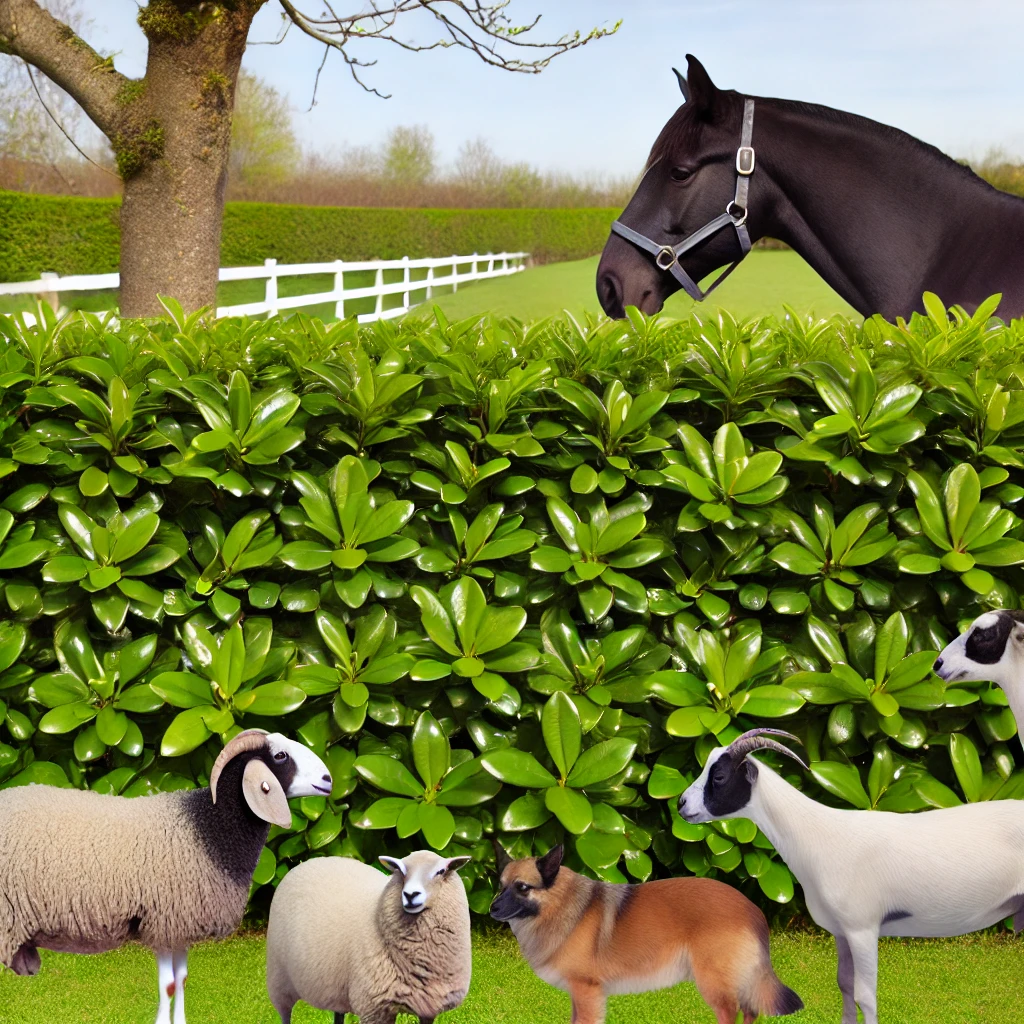
And with dense foliage and a growth rate that is fast and tolerant of being exposed to salt-laden winds, it makes a hedge that is lush green and apparently stands the test of time. But while Griselinia excels in the garden, what happens when animals, particularly horses, sheep, dogs, and goats come into contact with this verdant beauty?
Is the hedging Griselinia potentially dangerous or would these animals be able to graze free of worry? The present paper will give insight into the toxic potential of Griselinia hedge in various animals and make a detailed, clear breakdown of the effects it may have on horses, sheep, dogs, and goats.
Griselinia: An Overview
Before diving into the potential toxicity, let’s find out why Griselinia littoralis is a favorite hedging plant. Better known as New Zealand broadleaf, Griselinia is acclaimed for its thick, waxy leaves, plus its tendencies toward vigorous growth.
It is amenable to pruning and grows in varying climate conditions, fitting the bill for so many landscapes and property owners. You’ve probably seen it put to use, screening out neighbors, creating property lines, or covering driveways. It will give any area an attractive, structured appearance.
This raises, however, one question: while its fresh green, shiny leaves may be aesthetically pleasant, do they have any useful or harmful effects on animals?
Horses and Griselinia: An Up
First off, our horse buddies. Horses gain infamy for nuzzling at things they shouldn’t, and the leaves of a Griselinia hedge are unfortunately firmly in that camp. While it’s not a plant that is widely considered to be super poisonous, there is enough concern around the potential toxicity that owners should be cautious.
The ingestion of small quantities of Griselinia leaves would not do any harm immediately, although the ingestion of large quantities might produce a harmful response. The horse is irritated by certain compounds in the plant that, in large quantities, tend to irritate the digestive system of the horse.
The digestive systems of horses tend to be very sensitive. The introduction of foreign matter, such as that found in plants like Griselinia, forms a critical predisposing factor to horse colic, manifesting in a condition with signs ranging from just mild discomfort to problems that may endanger its life.
The symptoms may comprise stomach pain, sweating, and rolling.
However, since a horse is an inquisitive animal and many of them have an insatiable desire to chew, Griselinia hedges must be fenced. It may not be the most poisonous plant altogether, but where horses are concerned, it is always better to be safe and hedge Griselinia.
Sheep: Small Bites, Large Footprint?
Now, what about sheep? These woolly creatures are said to be much more selective grazers, which does not make them immune to the risks.
Sheep is smaller than horses and has a more robust digestive system, but this doesn’t mean that they are out of the woods when it comes to Griselinia. In the leaves, there are mild toxins that, if ingested in large amounts, would give the sheep digestive problems.
While not normally appealing to sheep if enough other food is available, during times of scarcity, they might just take a nibble.
Sheep that have taken small quantities of the hedging griselinia may not show any signs at all, but large amounts can lead to gastrointestinal upsets, including diarrhea. At its most extreme, this leads to possible toxicity. The best solution is to keep sheep away from Griselinia hedges to prevent accidental grazing.
A well-fed sheep will probably ignore the plant altogether, but it is best not to take chances.
Dogs and Griselinia: Man’s Best Friend Meets a Green Foe
But, as much as we love our four-legged friends, dogs are known to try out their surroundings with their mouths. That is gnawing on a stick, nibbling at grass, or munching on leaves – sadly, whatever is new goes into a dog’s mouth. So, where does the Griselinia hedge fit into this equation?
The good news is, Griselinia littoralis hedging is considered mildly toxic to dogs. Swallowing a small amount of the plant wouldn’t result in too much distress. This isn’t to say there’s no risk; for instance, should a dog consume large amounts of the leaves of the Griselinia species, then it may cause some mild gastrointestinal upset, such as vomiting or diarrhea.
Happily, dogs tend to have no great taste for Griselinia, so the chance of them gorging on the hedge is not very high. It is always good to keep a close eye if you have very curious or chew-happy dogs. If your dog has been inside the hedge, look for the signs of digestive upset and give the vet a call if you are concerned.
In general, dogs and hedging Griselinia can coexist together well, without a lot of the hyperbole attached to the much-mentioned plant causing any problems, but as always with animals, prevention is better than cure.
Goats: The Grazing Wild Card
Oh, goats: cheeky, determined creatures that will eat nearly anything that they can chew with their hooves—be it a tin can (myth but point taken) or your favorite shrub. With goats being what they are, Griselinia is a bit of a wildcard.
Goats are more natural browsers than sheep or horses, and their digestive systems cope with a greater range of plants. Griselinia is not a plant that goats especially like to eat, although the odd hungry goat may well sample it. The same applies as for sheep – trace quantities are not likely to have any effect, but larger intakes can lead to gut irritation and low-level toxicity.
Interestingly, goats are also known to have a more robust stomach and can effectively handle a far greater range of plant material than most other grazing animals. While Griselinia hedge may not be as toxic, it would be prudent enough to avoid its access to the plant since it has been proved that one cannot be too careful when considering the browsing habits of goats.
Using The Hedging Griselinia As Instant Hedging
Glorious Griselinia: Instant Privacy with Smart Planting by Spacing
Setting up an appealing, green boundary around your property does not necessarily be expensive. For those of you who have looked at these costly, fully mature hedges, wondering whether there was an option, less expensive, that does not sacrifice functionality, well, let me please you by informing you that things are different.
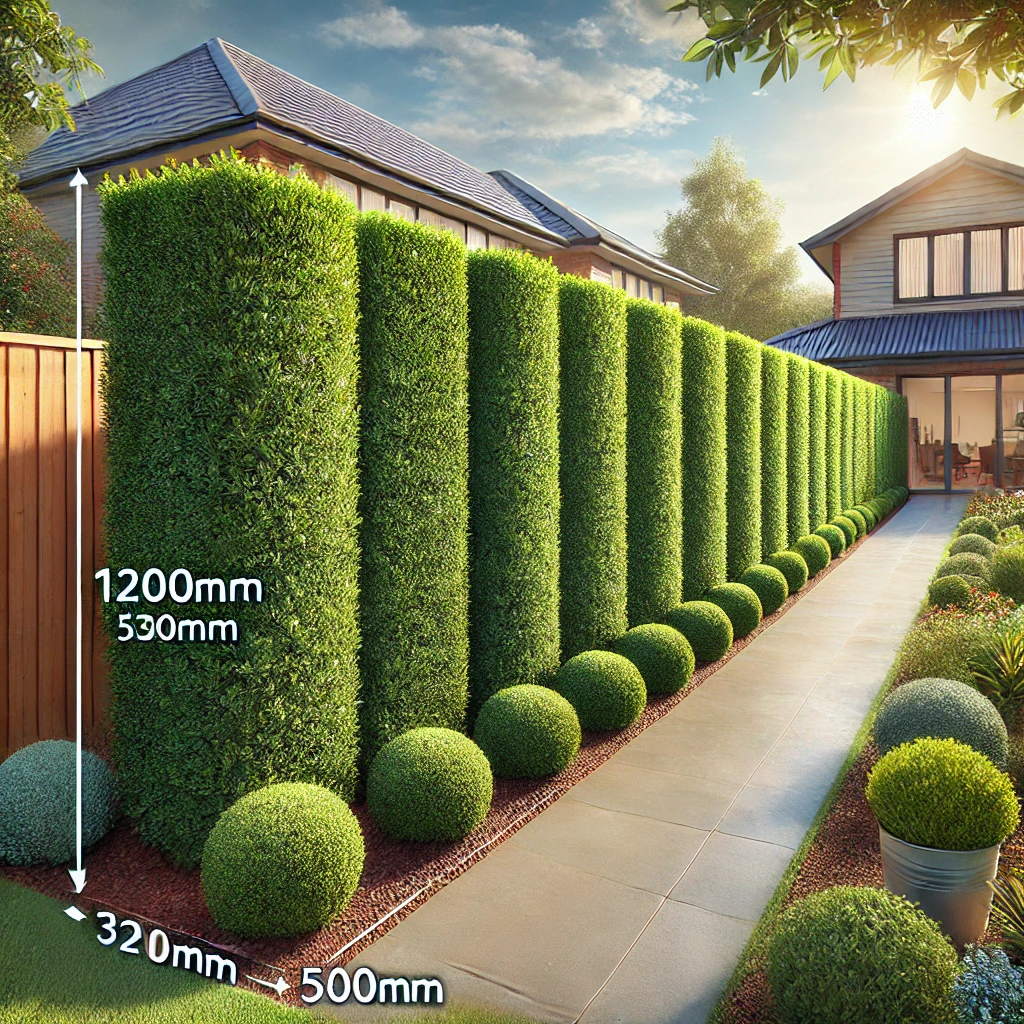
With a little planning, hedging Griselinia plants can give a very near instant hedge effect without the instant price. Using 1200mm tall Griselinia plants and planting either at 500mm or 333mm spacings give a near-instant hedge that, to many a person’s eye is just as good in many cases, as instant hedging in New Zealand does come in at.
Now, that’s what I would call a smart move. Let’s see how this can help you get the best of both worlds: thrifty yet bedazzling hedging for privacy, wind protection, and adding beauty to your space.
Why Choose Griselinia for Hedging?
First of all, let’s explain why Griselinia is such a favorite in the world of hedging.
Griselinia is botanically known as Griselinia littoralis. This plant shows hardiness and grows fast, showing its suitability for hedging in New Zealand’s varied climates. Tough, reliable, but most of all, handsome, Griselinia bears shiny, bright green leaves and will tolerate coastal conditions, a wide range of soils, and strong winds.
Whether it be in a rural, urban, or coastal situation hedging Griselinia will accommodate all with aplomb.
But what really sets Griselinia apart is how fast it grows. Whereas some plants can leave you waiting for years for a decent hedge, Griselinia gets to work fast. With the right care, you will have a thick, lush hedge before you know it.
The power of 1200mm-tall plants. Now, being impatient to get that privacy hedge up and running, the thing you will be executing is 1,200mm tall hedging Griselinia plants. They aren’t the baby plants you would have to raise with a lot of care for many years before seeing any results. Already at 1.2 meters in height, it is well established and gives you a head start on creating that dense leafy wall you so seek.
Planting taller Griselinia plants cuts down the amount of time that is required to essay a mature-looking hedge. While some instant hedging NZ products boast about their fully grown and ready-to-go features, this 1200mm plant offers almost the same effect with just a fraction of the cost. And here’s where the spacing comes into play.
Smarter Spacing: 500mm versus 333mm
How often you plant Griselinias determines the secret to a quick, dense hedge. You can plant them 0.5 meters apart if you want them to fill in reasonably quick, or at 0.33 meters apart if you need it sooner.
Spacing of 500mm: More traditional approach.
Planting your 1200mm tall Griselinia plants 500mm apart gives them plenty of room to spread their roots and grow, while the plants will still fill in the gaps fairly quickly. After a year or two, you will start to notice that your hedge does indeed form a full, leafy barrier that looks like it has been there forever.
This spacing works if you aren’t in a hurry to achieve the fully filled-out look but still want something that will provide privacy fairly soon.
333mm Spacing: If you want an instant looking hedge but do not want to spend money on mature instant hedging NZ products, then 333mm spacing is an excellent alternative.
Because you’re planting your Griselinia closer together, you’re sort of fast-forwarding the joining process into a continuous wall of green.
You are practically guaranteed an instant-looking hedge without the cost with this spacing. These plants will fill out more quickly and form a continuous hedge much denser and lusher in a much-reduced time frame.
Both are effective, but the latter speeds up the hedging process if one is in a really big hurry to get that near-instantaneous hedging effect.
Instant Hedging vs. 1200mm Griselinia: Which Is Better?
You might find yourself saying, “Why not just buy instant hedging nz?” While buying instant hedging NZ options are very desirable, especially if you are looking for that instant privacy, it does come with a pretty substantial dollar amount. Fully mature hedging is mostly sold at a premium, and for good reason: it’s ready to go the instance you plant it. However, that convenience comes at extra cost.
But using 1200mm tall Griselinia plants gives you practically an instantaneous hedge effect without the financial stress. You can plant these closer together-just 333mm apart-and you achieve in a short period of time almost the same effect as mature hedging.
What’s more, since Griselinia grows fast, you could be out of your wits with how fast those gaps will fill in. So, while that would have been instant hedging, suitable for a deep-pocketed, impatient person, the 1200mm Griselinia route is infinitely more budget-friendly and quite rewarding for the average homeowner.
How to Care for Your Griselinia Hedge
Of course, with the best planting strategy in place, your hedge isn’t going to do great without some TLC. To ensure your Griselinia grows quickly and remains healthy, make sure you:
Water Regularly: The first year is very critical for your Griselinia hedge to get established, and hence it needs plenty of water. Keep the soil moist, especially when it is a dry spell. Feed Your Hedge: Like all plants, Griselinia will appreciate regular feeding. A balanced fertilizer applied at the growing season will contribute to your hedge becoming thick and strong.
Prune Wisely: Griselinia is quite tolerant of pruning, so don’t feel afraid to give it a go. Regular pruning encourages bushy growth in your hedge, helping it to fill out faster.
Pest Control: Even though Griselinia is a hardy evergreen, it is always good to be alert for any type of pest or disease. If you see some, handle the treatment as soon as possible to maintain your hedge healthy.
Conclusion: Griselinia for Instant Hedges within Budget Hedging Griselinia plants 1200mm tall really are an excellent way to obtain that instant hedge look without the cloud-breaking costs associated with our fully mature instant hedging NZ products.
Plant them at either 500mm or 333mm spacings, and you’ll be enjoying a beautiful, dense hedge for privacy, wind protection, and a stunning green backdrop to your garden in no time. Follow the right care, add a little patience, and you can have a Griselinia hedge as good as any of those instant hedges-but without the hefty price tag.
So, if you’re ready to create a natural, cost-effective boundary for your property, give 1200mm tall Griselinia plants a go and watch your garden transform!
The Many Applications Of The Hedging Griselinia
Griselinia Hedging: The Most Effective, Cheapest, and Almost as Good as Instant Hedging
Perhaps no other plant in the realm of landscaping offers such versatility, beauty, and economy as Griselinia. Being an evergreen with dense, glossy green leaves and fast-growing, it forms a great hedge not only within gardens and commercial properties but even in urban areas.

If one is looking for a hedge that would seem to be there for years without necessarily bearing the high price for fully mature instant hedging, then hedging Griselinia is one’s answer.
Whether it be planning out a garden maze, adding some greenery to an apartment balcony, or even looking to create a private oasis in an industrial setting, Griselinia has a fit for each. It can provide you with that instant hedge look with a fraction of the investment required by these expensive fully-grown hedges.
Let’s dive into the many applications this versatile plant has and how it compares to instant hedging NZ solutions.
The Garden Maze: A Classic with a Twist
Once the hallmark of grand estates, garden mazes make a comeback into today’s landscapes with vengeance. This is one desirable, playful, and mysterious element of a garden. Traditionally, garden mazes were made from plants that took years to achieve the tall, dense walls required. But why wait decades when you can make essentially the same effect in a fraction of the time?
The Hedging Griselinia is ideal for modern maze gardens. Planting 1200mm tall Griselinia combined with the right spacing-as close as 333mm for that dense, instant effect-will grow into high and thick walls in a very short time.
Because of its fast growth, your maze will have a very quick development: fills in holes, the mazing will add up to a green, leafy labyrinth that visitors can really get lost in-without having to wait some years for it to grow in completely. At the same time, tolerance from Griselinia to pruning allows keeping the maze walls neat and neatly trimmed.
In fact, on these counts, Griselinia is almost as good as mature instant hedging, without the price tag since you get the same height and density.
Planter Boxes: Greenery on a Smaller Scale
Not all of us have sprawling gardens to work with, yet that does not mean we cannot enjoy the beauty of hedging plants like Griselinia. Another use for this plant, which is quite innovative, is within planter boxes. Because Griselinia has a compact root system and is hardy, it easily lends itself to container gardening.
The planter boxes on apartment balconies or small urban courtyards pop out privacy screens and add touches of nature to hard, concrete spaces. Because Griselinia is fast-growing, even in small areas, it will thrive and give lush greenery that softens harsh lines, creating a natural, serene environment.
The beauty of this is that Griselinia does not need the deep soil that other hedging plants do, so it can be absolutely at home in planter boxes. Instant hedging is possible for NZ container gardening; this just tends to come in much more expensively and requires a bit more maintenance. Griselinia is easy to care for and relatively inexpensive, hence a good alternative.
Apartments and Urban Spaces: Bringing Nature to the City
The concrete jungle sometimes has a dearth of greenery, but Griselinia hedges have their contribution to make in urban landscapes, too. With nature being taken inside the cities in almost everything, hedging Griselinia has found its place in apartment complexes and urban developments.
Architects and designers now make use of Griselinia by giving more vertical greenery to a building, enhancing rooftop gardens, and creating living walls.
One of the great advantages of using Griselinia within built environments is its adaptability. It will thrive in tight spaces, tolerate pollution, and yet still grow into a healthy, dense hedge. Plant it along walkways or use to line courtyards and common areas, hence providing not only aesthetic beauty but also a bit of natural soundproofing from the bustle of the city.
And speaking of the view, how about privacy? In populated cities, privacy can be difficult to find. Griselinia hedging provides a leafy screen that might block a nosy neighbor from a balcony, a patio, or a garden space. Again, since hedging Griselinia is rather inexpensive, many would consider this again over the highly priced instant hedging NZ products.
Commercial and Industrial Applications: Going Green on a Grand Scale
Griselinia isn’t just for gardens and apartment balconies. Its robust nature makes it an excellent choice for commercial and industrial settings, too, whether the purpose is to screen off unsightly areas, provide wind protection, or just add a bit of green to otherwise barren spaces. Griselinia hedging gets the job done.
On commercial properties, Griselinia can line the edges of parking lots and property boundaries, even create green buffers between buildings and streets. With fast growth and dense foliage, this is just what businesses have been looking for to add that bit of privacy or aesthetic appeal, and not necessarily breaking the bank while doing so.
Griselinia can be used industrially to screen off machinery, storage areas, or other functional parts of a site that are not particularly attractive. Because it is so hardy, it will tolerate harsher environments, which for some might include heavy winds and even pollution and dust. That makes it an ideal solution for adding greenery to those spots where little else seems to grow.
These plants again provide a feasible, reasonably priced alternative to instant hedging NZ options without sacrificing aesthetics or any respect whatsoever.
Griselinia as Windbreaks
Griselinia hedging is also amazingly good as a natural windbreak. For coastal properties, farms, or rural settings where wind can be a nuisance constantly, planting a Griselinia hedge will help protect against elements. Indeed, it works very well for such purposes, owing to thick, evergreen leaves that create a strong, thick barrier that shields away the wind.
Windbreaks not only protect property from strong gusts but also help protect other more sensitive plants, which may suffer from wind damage. Griselinia Hedge can double as a natural barrier for any sort of garden or crop that needs protection to maintain its healthy growing environment without investing highly in costly fencing or barriers.
Instant Hedging nz vs. Griselinia: A Cost-Effective Alternative
Instant hedging is definitely a tantalizing prospect for those who require an instant effect. Full-grown, ready-to-go hedges will instantly provide you with a screen that is fantastic for privacy purposes or some much-needed visual effect.
The problem with such options, however, is that they come at very hefty prices, which deters many a homeowner and business alike from using them in the first place.
This is where hedging Griselinia comes into its own. Plant 1200mm tall Griselinia plants with smart spacing-500mm or 333mm, depending upon how quick you want the hedge to fill out-and you can achieve an instant hedging look without the cost of fully mature plants.
Since Griselinia is very fast-growing and dense, it gives the same feel as instant hedging over time without the upfront expense.
For this reason, whether it’s hedging for a maze in your garden, lining a planter box, filing in apartment greenery, or putting up a privacy screen for commercial property, hedging from Griselinia gives one the best of both worlds: near-instant effect at a fraction of the cost.
Care for Your Griselinia Hedge
Of course, no hedge will thrive without a little care. Thankfully, Griselinia is a low-maintenance plant that proves pretty easy to manage once it’s established. Here are a few tips that will keep your Griselinia hedge at its best:
Watering: This plant requires frequent watering, especially in the initial year after planting. Keep the soil moist, especially in dry seasons.
Fertilizing: A balanced fertilizer at the beginning of the growth season will give your hedge a boost and encourage it to grow strongly. Pruning: Pruning should be done. The good thing is that Griselinia does not have any problem with hard pruning, so it won’t hurt to give it that trim. This regular pruning in turn would help the plant grow much thicker and bushier, with no gaps to offer a neat hedge.
Pest Control: Although Griselinia is thought to be largely pest resistant, there is always the chance that diseases and pests can occur. If you catch these issues early, then the hedge should remain healthy and continue to grow.
Conclusion: A Hedge for Every Setting Hedging Griselinia offers great versatility and is economic for a wide range of applications, whether it be to create a garden maze, add privacy to an apartment balcony, or green up the industrial site – the Griselinia can provide the instant hedge effect you’re after without the price tag of fully mature instant hedging NZ options.
Fast-growing, quick to form a dense hedge, and tolerant of all manner of extremes, this is a popular hedging plant for residential and commercial purposes alike. With a little care, your Griselinia hedging plant will, in no time, reward you with a lush, green hedge that looks as though it has been there for years. Why wait for an expensive instant hedge when you can get nearly the same effect with Griselinia?
The Best Seasons For Maintenance Of The Hedging Griselinia
Seasonal Care for Hedging Griselinia: A Year-Long Guide
Griselinia is a fast-growing, dark-green-leaved evergreen popularly used for its robust and handsome hedges. Like any other plant, however, your Griselinia hedge requires periodic care throughout the year. A few seasonal tasks will help you keep your hedge healthy and full, vibrant, and impenetrable enough to block out unwanted views or add visual interest to your property.

In this article, we will cover what you need to do during the different seasons to keep your hedging Griselinia in top shape. Whether you are developing a natural privacy barrier, or seeing your Griselinia hedge compete in its look with the instant hedging NZ products in the market, it requires regular maintenance work.
Spring-The Season of Growth
This is the spring season when hedging Griselinia really comes into its own. During this period, it starts its most vigorous growth phase, and attention should be given to its needs if you wish it to thrive.
- Pruning: The ideal time for pruning your Griselinia hedge is in early spring. If the plant has caught some frost damage, it should be removed after the danger of frost has passed. This period’s pruning helps in maintaining a tidy shape. Light trimming is enough; care must be taken not to over-prune.
- Fertilizing: Griselinia, just about to kick into its growth period, becomes starved for nutrients at this point. A balanced fertilizer with heavy doses of nitrogen will provide the energy needed to push out fresh leaves and make it thick. First apply the fertilizer at the base of the hedge and then water well. This being done in spring gives a great start to your hedge for the rest of the year.
- Watering: While the Griselinia is relatively drought tolerant when established, spring can be a time for unpredictable weather. If you are in a period of drought, make sure to give your hedge a deep watering to reach the roots. Deep waterings encourage strong root systems, and that’s what you want for that dense, healthy look.
- Pest Control: New growth is susceptible to pest infestation. Watch your hedge for aphids or other insects that may have a snack or two on your hedge. The mild insecticidal soap will take care of any small problem before it gets out of hand.
Spring really sets the trend for the rest of the year. By summer, a well-cared-for Griselinia Hedge will be in excellent fettle to receive vigorous growth.
Summer Keeping It Cool
Summer tends to be one of the most stressful seasons for any type of plant, including hedging Griselinia. With heat and possible drought, your hedge may need just a little bit more TLC to keep its best appearance.
- Watering: The most crucial undertaking in summer maintenance is consistent watering. While Griselinia is hardy, extended periods of dryness will stress the plant. Water your hedge either very early in the morning or late evening, hence reducing evaporation, and ensure that wetting of the roots will be thoroughly done. If you are after that ‘instant hedging NZ’, consistent moisture helps keep that foliage lush and dense.
- Mulching: Organic mulch applied at the base of a hedge would help in retaining moisture and keeping the roots cool. Mulching not only preserves water but will, in addition, prevent weeds that might compete with your hedge for nutrients.
- Pruning: It is an excellent time for that second light trim. The growth does slow down compared with spring, but you will still want to shape up the hedge somewhat to prohibit it from becoming too unruly. When it concerns merely trimming stray branches and shaping the general structure of the hedge,.
- Pest Control: Summer is the time that insects love, so a watchful eye needs to be had. Check your Griselinia on a regular basis now that the weather has heated up, particularly when the humidity is evident. If you do notice any issues at all, deal with them promptly, so no damage occurs to the new growth happening.
Summer requires a bit more attention, mainly when the weather turns hot and dry. However, the little attention it needs really goes an extra mile in making your Griselinia look equally appealing as expensive instant hedging.
Autumn: Getting Ready for the Cold
Now that the temperatures are cooling, it is time to prepare your hedging Griselinia for the winter months. Autumn is a time of winding down, but there is still work to be done in making sure your hedge weathers the cold without issue.
- Pruning: Griselinia hedges love to get one final trimming early in autumn before winter really starts. It is important for this pruning session to be merely a light trim that shapes and removes damaged or dead branches, not heavy pruning. You want the plant to take as much energy with it into winter as possible.
- Fertilizing: While Griselinia requires less fertilization during autumn, some sideways help by applying slow-release fertilizer will help prepare it for the winter. This will provide a boost of nutrients that will keep it strong over the winter months and ensure it is ready to burst into life once spring comes around again.
- Water: Before winter kicks in or during the onset of winter, make sure your hedge is well watered. Just like in summer, deep watering will keep the roots robust and may prevent stress as the plant starts going into dormancy. When the soil is dry, the frost could be damaging to the sensitive roots.
- Pest and Disease Control: Autumn may bring in moist conditions, which sometimes will also tend to encourage fungal diseases. Keep an eye on your hedge for any mildew or other fungal problems- lookout and treat either if necessary. While Griselinia is really hardy, it is always better in terms of pest and disease management to be ahead of the game.
Autumn is all about preparing your Griselinia for the months to come. Give it that extra bit of care now, and it will be ready to flourish again by the time spring comes.
Winter: The resting period
Like most hedging plants, the winter period is the quietest time for maintenance concerning Griselinia. The plant goes into a period of dormancy, which means less active growth, but that does not imply you can completely neglect it.
- Watering: While the growth of your hedge has reduced during this period, it will nonetheless need periodic watering infringing dry and frosty winters. Keep the soil from completely drying out, but handle with care to avoid overwatering, as the additional water may freeze thereafter and damage the roots.
- Pruning: Avoid heavy pruning this time of the year. Of course, any branches that get damaged during winter storms or because of frost can be taken off, but that would avoid any stress on it.
- Mulching: If you didn’t mulch in the fall, this is a good time to put a protective layer around the base of the hedge. Mulching insulates the roots, keeping them warmer in cold snaps and reducing the chances of frost damage.
- Pest and Disease Monitoring: Admittedly, most of the pests are not extremely active during winter; nonetheless, it will be great to keep an eye out now and then. Periodically inspect the hedge for disease or wildlife damage and take remedial measures where needed.
Winter is a time of rest for the hedge, but a little TLC will guarantee it’s ready when the warmer months make their appearance and the plant assumes growth again in vibrant colors.
Instant Hedging vs. Griselinia: Year Round Maintenance
But one thing is for sure in comparing hedging Griselinia to instant hedging NZ options: it provides a similar aesthetic value as any other hedge planting, but done on a more hands-on approach. Instant hedging may be an instant fix, but again, it’s usually more costly and still requires year-round care to keep its look up.
Although economic in nature, Griselinia grows best with appropriate seasonal care, and with frequent care in terms of regular watering, pruning, and feeding, your Griselinia hedge competes with even the most expensive instant hedging NZ for a dense and healthy-looking barrier throughout the year.
Conclusion: A Little Care Goes a Long Way The reward of caring for a Griselinia hedge is many folds, and the results show. With this seasonal care routine, your hedge will remain healthy, strong, and beautiful throughout the year. While each separate season brings about a different set of tasks, constant care translates to a continued, thriving Griselinia hedge that enhances your garden or property year after year.
Whether going for the look of instantaneous hedging NZ options or just desiring a lush, green barrier to enjoy, hedging Griselinia proves a cost-effective and attractive choice. A little season-to-season care and one will have a hedge that continues to be a stunner in any landscape.
How To Propagate The Hedging Griselinia From A Cutting
How to Propagate Griselinia Plants from a Cutting—Green Thumb Tips for Success
Whether you simply love the look and ease of the Griselinia plant, or you don’t want to spend a bundle in adding more plants for the home or garden, multiplying its plants by cuttings is an easy, satisfying, and perfect option to take.
Not only that, it’s affordable. Whether you are looking to have a beautiful privacy screen or trying to mimic the lushness of instant hedging in NZ, propagating Griselinia from a cutting is what would be your best solution.
In this guide, we take you through the process step by step with best practice guidance along the way. Let’s pick up our garden tools and get to work.

Step 1: Choose the Right Time of the Year
Timing is everything when propagating Griselinia from cuttings. The best time to take cuttings is during late spring or early summer when the plant is actively growing. At this time, the stems are firm but flexible; therefore, they make perfect material for propagation. Take cuttings not in autumn or winter, for during these months growth is minimal, and so rooting becomes less successful.
Step 2: Choose a Healthy Parent Plant
For your cuttings to have the best chances at survival, find a healthy and mature Griselinia plant from which to take your cuttings. Look for a plant that’s free of pests, diseases, or any signs of damage. A healthy and well-taken care of plant is going to sport cuttings with the best possible chance of success. This applies as much to the creation of a hedge that can rival instant hedging NZ.
Step 3: Make the Cutting
Now that you’ve found a parent plant that’s healthy, it’s time to make your cutting. You should employ a couple of clean, sharp pruning shears so that you can make a nice clean cut. Select a non-flowering stem and make a cutting that is about 15-20 cm long. Make your cut just below a leaf node (where the leaf joins the stem), as this is where new roots are most likely to form.
After cutting, remove the lower leaves, leaving just a few at the top. This reduces water loss and allows the cutting to concentrate its energy on rooting and not keeping an excess of leaves hydrated.
Step 4: Prepare the Cutting for Rooting
Before you plant your Griselinia cutting, it’s a good idea to give it a bit of a head start toward root growth. You can dip the cut end of the stem into rooting hormone powder. This is not strictly necessary, but the amount of success in rooting is far increased, particularly for beginners at propagating plants.
Rooting hormone helps to stimulate root development while decreasing the chances of a cutting rotting before it can successfully root. But even without rooting hormone, you can do this. Just take special care to really keep an eye on that cutting in the early stages.
Step 5: Plant Your Cutting
Now, planting your cutting is going to be the fun part! Find a small pot and fill it up with well-draining potting mix. You can either use a special mix for cuttings or a mix of compost, sand, and perlite. This ensures there is a free and open mixture that allows excess water to easily drain off, avoiding the cutting from being waterlogged.
Stick the cutting in the soil; make sure that the lower node, where you removed the leaves, is buried in the mix. Then firm the soil gently around the cutting to ensure it stands up.
Step 6: Create a Mini Greenhouse Effect
To prevent your cutting from drying out and to help with rooting, create a mini greenhouse. Put a clear plastic bag over the pot or use a clear plastic container that you have set the pot in. This will keep humidity surrounding the cutting, which is an essential element in keeping it hydrated as its roots grow.
Be sure to prop up the plastic so that it doesn’t touch the cutting directly—this will only lead to fungal issues. You can even poke a couple of small sticks or skewers into the soil to frame the plastic off of the cutting.
Now, place the pot in a warm, bright location. Bright indirect light is best to promote root development.
Step 7 Water and Wait
Water the cutting thoroughly after planting, and keep the soil moist but not soggy in the following weeks. Be sure to check the soil now and again to ensure that it does not dry out just be careful not to overwater. For Griselinia doesn’t want to be left standing in waterlogged earth, good drainage is key.
Rooting may take from a few weeks to a couple of months, depending on the temperature. Just be patient at this point. And if the leaves stay healthy and green, that is a good sign of rooting just below the surface.
If you can afford to wait a few weeks, gently tug on the cutting to see if it has rooted. If you pull and there is resistance, then that means the cutting has already rooted and it’s time to proceed to the next step.
Step 8: Replant Your New Griselinia Baby
When your Griselinia cutting has been successfully rooted, it is time to transplant it into a larger pot or directly into the ground. If you’re going to do the classic hedging Griselinia effect, try putting your new plants at even intervals along your property line.
Whether you are planning for full privacy screening or looking to create the effect of instant hedging NZ, it is all about getting the spacing right to achieve the desired effect.
Plant the rooted cuttings in well-drained soil, watering thoroughly after transplanting.
Step 9: Looking After Your New Hedge
Now that you have propagated a Griselinia plant from cutting, you should continue to care for the growing plant. Water the young plants regularly during the first year, especially in dry periods.
Once established, Griselinia requires very little attention; it certainly isn’t demanding in long spells of dry weather, hence why this is such a popular choice with people who don’t want to spend hours on end with garden work.
Lightly trim the plants back during their first growing season in order to encourage bushier growth. Regular pruning will fill your hedge up faster, maintaining a neat appearance.
Conclusion: A Green Thumb’s Reward
Growing Griselinia from a cutting can be a very satisfying exercise. Before you know it, your little investment of time and effort in that one plant will have grown into a flourishing hedge that you would have paid through the roof for if you had gone with any of those outrageously expensive instant hedging options in NZ.
Moreover, since you will be propagating through cuttings, you get to save money and watch how your garden flourishes under your hands. And that is how the next time you take notice of one of those hedges, remember that with the right set of techniques you can raise one from scratch.
Quickhedge – The Cheapest Instant Hedging NZ Has On Offer
Quickhedge: The Best Value in Instant Hedging NZ
If you have been shopping around for instant hedging in New Zealand, chances are that you will have experienced some pretty shocking prices along the way. Most companies charge over $300 per meter just for pick-up! But here at Quickhedge, we believe you shouldn’t have to break the bank to enjoy a beautiful, fully grown hedge. That’s why we charge just $90 per lineal meter and that includes delivery and planting.

You might wonder how it is that we can offer such a great price vs other companies. Well, the answer lies in our smart use of 1200mm tall plants and careful planting strategies that create the same lush, green look of expensive instant hedging NZ solutions – but at a fraction of the cost.
How Griselinia Gets You Instant Hedging for Less
When you want to create that natural, beautiful boundary, one of the best ways you can do it is by hedging with Griselinia. Griselinia is fast growing, has dense foliage, and is hardy; just what you need in a plant to create privacy screens, windbreaks, and garden edges.
How Griselinia at Quickhedge Works
We maximize Griselinia by using 1200mm tall plants. We carefully space 2-3 of these plants per meter, which quickly fill in to give you a dense, lush hedge. You get the same instant effect as those who spend $300 per meter on fully mature hedges but without the eye-watering price tag. Our slightly smaller plants afford you the best of both worlds; a hedge that appears to have already fully grown at around half the price.
The Math Behind the Savings
Breaking this down a little. Most companies charge in excess of $300 per lineal meter for pick-up only. That does not include delivery, and it certainly does not include the cost of getting someone to plant the hedge for you.
At Quickhedge, for only $90 per meter, you get everything included, from the plants all the way to professional planting and delivery. Put another way, no heavy lifting, hole digging, or guessing at how far apart to space your plants. Our team will handle it all. That’s how we pull off the cheapest, instant hedging NZ has to offer without skimping on quality.
Why Griselinia Works So Well for Hedging
You might be wondering why we use Griselinia and not another type of plant. The answer is fairly simple: hedging Griselinia is beautiful, tough, and very low maintenance. This plant grows very well under the New Zealand climate, tolerating the coastal winds and cold inland temperatures.
Griselinia also grows fast, which is key when you’re looking to create a natural privacy screen quickly. The 1200mm tall plants we use are already mature enough to provide an immediate visual impact, and in no time they will fill out even more, showing you the full effect of a mature hedge.
Griselinia requires no constant pruning or special care in comparison with other plants. In contrast, it is hardy, evergreen, and retains its color all through the year, thus keeping your hedge looking attractive throughout the four seasons.
Delivery and Planting Done Right
One of the biggest advantages when dealing with Quickhedge compared to other instant hedging NZ is that we don’t just sell you the plants—we plant them for you too. That’s part of the $90 per meter price.
Planting a hedge may sound easy, but this calls for precision work. Spacing the plants right, getting the roots in the ground correctly, and ensuring the soil conditions are just right pose difficulties to anyone without experience. Allow our team to do your planting to ensure that your hedge is planted perfectly and looks fantastic from the very start.
Fast Growth with Little Maintenance
Once in the ground, you will be amazed at how quickly your Quickhedge hedge springs to life, filling in. Assuming you have taken good care of them, over time the plants will grow out even thicker and denser for that instant hedging look. Once this is done, the hedge will only need watering during the first year until the plants are well established.
Griselinia hedge trimming is fairly minimal compared to other hedge plants. Trimming may only be required to shape the hedge once or twice a year. This is because it is an evergreen variety, with greenery to be enjoyed throughout the year, without the worry of leaves falling in autumn or the hedge looking sparse in winter.
Quickhedge: The Clear Choice for Instant Hedging in NZ
Both the costs and the convenience of Quickhedge make it the clear choice for an instant hedging solution in New Zealand if one is looking for quality. For the same price of only $90, you will already have the plants, delivery, and professional planting in your garden, whereas other companies charge over $300 per meter for pick-up alone.
By using 2-3 1200mm high Griselinia plants per meter, we create an instantly full, lush, and mature hedge. And you never sacrifice quality for affordability. Instead, you have the best of both worlds—a beautiful, long-lasting hedge that does not strain your bank account.
So, if you are looking forward to setting up a natural boundary, adding privacy to your garden, or simply want an aesthetic upgrade of your premises, then Quickhedge brings the best money-saving answer. Why pay more when Quickhedge will deliver everything and plant it for $90 per meter? You can get us to produce a beautiful-looking hedge for you at a fraction of the price.
Instant Hedging Equals Instant Privacy
Instant Hedging NZ: Get Privacy and Screening

We’ve all been there—you move into a new house, and suddenly realize that your dream of a private backyard oasis is at risk because your neighbors are a little too close for comfort. Be it a busy road, a prying neighbor, or just the urge to have some cozily defined space, at times one surely cannot wait for nature to take its sweet time. So, that is where Instant Hedging NZ comes to your rescue.
An instant hedging is done in outdoor space for those in need of privacy and who cannot afford to wait for another second. Griselinia is one of the best options for most homeowners in New Zealand because of the beauty, durability, and speed that it features. Let us see why instant hedging should be your first choice if you need fast screening and how 1200mm tall plants help to get you the privacy you want in no time.
Why Instant Hedging?
First things first: why use instant hedging in NZ solutions? The plainest and easiest reason is time. Traditional methods of hedging can often take years to grow into a proper barrier. During that time, you’re left exposed, waiting for your plants to mature and fill in the gaps. There’s something commendable about the slower pace of growing a hedge, nurturing it along.
Instant hedging provides a fully-grown or near-fully grown hedge right from the outset. You do not have to wait for years for it to mature high and thick enough to block out that nosy neighbor or dull the noise from a nearby street. With instant hedging Griselinia, you get a fully grown-looking hedge that has been there for years, giving both aesthetic and practical benefits right from day one.
Why use Griselinia?
There are no two ways about this: all hedges are not equally good as far as instant hedging goes. One of the best for the New Zealand climate is instant hedging Griselinia. It grows very fast, and its nice green leaves become thick and offer good coverage. It can also do well in a range of conditions, from coastal areas to inland gardens.
Griselinia is an evergreen, so it will provide year-round privacy and screening as opposed to some plants that are leafless during the winter months. For use as a windbreak, to screen an unsightly view, or to create a natural boundary, Griselinia will serve you well in both function and aesthetic appeal. As the perfect dense foliage, it will turn into a thick, impenetrable hedge and is so popular for instant hedging NZ.
Using 1200mm Tall Plants to Create Instant Hedging
As experts in using 1200mm tall Griselinia plants at Quickhedge, we can create the same effect achieved with fully grown instant hedging NZ products. Rather than charging you a fortune for fully mature plants, we found a clever way to create that instant hedge look at a fraction of the cost.
Here’s how it works: we plant 2-3 1200mm-tall Griselinia plants per meter, strategically spaced for a quick, full effect. These plants are already grown to a good mature size, so will provide an immediate effect, and within a very short time, they will grow and knit together to form a continuous solid hedge.
By using 1200mm plants we give you an instant hedge without the long wait, and without the hefty price tag that comes with purchasing fully grown plants. It is, therefore, a practical and cost-effective solution for anyone who needs privacy and screening quickly without compromising quality.
Other advantages of an instant hedging Griselinia
Aside from giving you a hedge fast, instant hedging Griselinia also offers many further benefits:
Durability: It is tough and can handle the varied climates of New Zealand. Whichever climate you live in, it will thrive and continue to give you that bit of seclusion all year round.
Low Maintenance: Once you’ve put your instant hedging Griselinia into place, it requires very little tending. The standard watering required in its first year provides a strong foundation, but after that it is relatively drought tolerant. You will only have to cut it back once or twice a year to maintain that neat and tidy appearance.
Beauty All Year Round: Being an evergreen, Griselinia keeps its leaves throughout the year; it doesn’t shed its leaves in fall, like other deciduous plants do. This means that, all year round, your hedging is there to provide privacy and screening, with a vivacious garden even through winter.
Rapid Growth: Although we use plants already of substantial height to provide instant effect, Griselinia is also especially rapid in growth. This means that in no time at all those small gaps of space between the plants will be filled with continuous hedge that looks natural and established.
Why Choose Quickhedge?
At Quickhedge, we pride ourselves on offering the cheapest instant hedging NZ has to offer. While most sell per meter for hundreds with fully developed hedges, we use 1200mm tall plants to bring you the same effect at a fraction of the price. At prices as low as $90 per meter, you will have your plants delivered and planted professionally, saving you time, money, and the headache associated with it.
We understand that not everyone has the time to wait for a hedge to grow, and not everyone wants to spend a fortune on instant hedging NZ options. That is why we have developed a solution offering both quality and affordability. Our team spaces the plants carefully so they will grow into a beautiful continuous hedge in no time and instantly provide you with the privacy and screening you need.
Instant Privacy with Instant Impact
If you need fast, instant hedging for privacy or screening, then Griselinia is the perfect choice. It creates the perfect barrier to block out noise, a peaceful garden retreat, or simply adds a natural border to your property with just the right touch of beauty, durability, and speed. Quickhedge gives an instant hedge that most resembles the other expensive hedges in the market. It will not take long before you get full greenery with an appearance of years.
So why wait for privacy when you can have it right now? Pick instant hedging, NZ with Quickhedge, and there is no waiting or massive expense to get all the benefits of a fully grown hedge.
Planting Instant Hedging In The North Island
Quickhedge: Instant Hedging Griselinia for Every Climate
In the fast-growing arena of creating an instant, full natural boundary, a lot of New Zealanders have made Quickhedge their first choice. Specializing in instant hedging using Griselinia, Quickhedge is bringing homes and businesses fast-growing, beautiful greenery across a wide range of regional locations.
Whether you’re in Tauranga, whose climate is sun-soaked, slightly cooler temperatures in Hamilton, or the geothermal heartland of Rotorua, Quickhedge has mastered the art of hedging Griselinia to grow well in any environment.

Instant hedging NZ often seems one-size-fits-all, but Quickhedge prefers a more bespoke approach, meaning their Griselinia hedges are matched with that particular area’s growing conditions. Let’s discover why Quickhedge’s instant hedging Griselinia in any climate is the best option for people looking for fast and affordable privacy in places like Tauranga, Hamilton, and Rotorua.
Tauranga: Hedging Griselinia in a Coastal Climate
Situated in a sunny, warm climate and close to the coast, Tauranga is pretty much a beautiful place to live. It’s also where your garden could have to rise to a few unique challenges.
This and the salty winds, and dry spells would be hard for some plants to bear but hedging Griselinia comes through easily. The hedging Griselinia is one plant that seems to do well in coastal environments, tolerating salty air and harsh winds much better than most other plants.
Quickhedge uses 1200mm tall Griselinia plants to create instant hedging NZ solutions that work brilliantly in Tauranga. The fact that it is carefully spaced means that growth will be relatively fast and, in no time, a luxurious, dense hedge will provide privacy and protection from the wind.
Griselinia is drought and salt tolerant—a fantastic choice for this coastal area, where many other hedges are really struggling to stay green and healthy. That it is an evergreen means that no matter the time of the year, your Tauranga property will always look full of life.
Hamilton: A Cooler Climate Calls for Tougher Hedges
Heading a little inland to Hamilton, there are some changes with the climate. The Hamilton region benefits from a cooler, more temperate climate compared to that in Tauranga, with colder winters and more rain.
While the temperatures here aren’t extreme, they can waiver just enough to pose a challenge for some types of plants. That is where hedging Griselinia comes into its own.
With Griselinia, which is able to cope with cooler but still grows fast conditions, Quickhedge ensures that their instant hedging NZ plants are perfectly suitable for the Hamilton climate. The 1200mm plants they use are already of sufficient height, providing instant impact. As they grow, they will quickly form a dense, natural screen.
In Hamilton, Griselinia’s toughness comes in very handy, as it tolerates wet conditions without getting root rot and such. The city receives moderate rainfall, which means you need not worry about watering Griselinia regularly; it is a very easy-care option for both homeowners and businesses in Hamilton.
With Hamilton Griselinia hedging, you’re promised the strength your hedge needs to last through seasonal weather changes, all while offering the instant privacy and beauty that you are clamoring for. It doesn’t matter if you’re trying to make a quiet garden oasis or simply blocking out the view from a busy street; Quickhedge’s instant hedging NZ solution has you covered.
Rotorua: Hedging with Geothermal Conditions
Rotorua’s unique geothermal activity makes headlines, but its distinctive soils and climate can surprise even the most seasoned gardeners. In these special circumstances, the Rotorua geothermal landscape, however, doesn’t always play magic with a hedge, but Griselinia is observed to be doing exceptionally well.
Adapting well under the circumstances, it performs brilliantly—even in the often sulfur-rich ground of Rotorua, which really puts the boot in where more delicate plants are concerned.
Quickhedge presents instant hedging in Rotorua with hardy and well-proven plants of Griselinia. The 1200mm plants are tough enough to handle Rotorua’s environmental quirks, with instant impact and fast privacy. Growing quickly and only needing a little maintenance, which is ideal for those who want a gorgeous hedge without the need to spend every available minute on it.
In Rotorua, where the natural environment can at times feel a little bare, having green foliage throughout the year is a real plus for Griselinia. The Griselinia hedge stands out some green, and it may give some sense of privacy in a region that feels like it should be tranquil, though geothermal vents and wandering tourists would easily disrupt that peace.
Why Quickhedge Is the Best Instant Hedging Solution in NZ
Quickhedge has a phenomenal ability to adapt its Griselinia instant hedging to suit conditions in every climate. But while other companies can offer generic hedging solutions that work perfectly well in one area but fail in others, Quickhedge takes the time to make sure its plants will flourish no matter where they’re planted.
You can take, for example, the 1200mm tall Griselinia plant, giving the same matured hedging effect but at a much reduced cost. The plants are already tall enough to make an impact and quickly grow into a thick, natural screen. This NZ instant hedging solution is perfect for those who need privacy or wind protection fast without selling out on quality or long-term durability.
Another of the great benefits of the Quickhedge instant hedging service is that you will receive delivery and planting. You do not have to worry about digging, measurements, or what spacing is necessary for the hedge to be placed and planted in. All this work is done by the professionals at Quickhedge, where your hedge is going to be planted and already set up to flourish.
Conclusion: The Top Instant Hedging for Absolutely Every Climate
Whether you are enjoying the coastal breezes of Tauranga, the cool air in Hamilton, or the geothermal wonders of Rotorua, Quickhedge instant hedging Griselinia offers a quick, effective, and affordable solution. With 1200mm tall plants and an approach uniquely tailored to suit local climates, Quickhedge delivers instant hedging NZ residents can trust in.
Griselinia is tough, evergreen, and allows instant hedging to be given throughout various regions. Fast growing and easy to care for, it gives immediate privacy and wind protection—all the aspects you would want from a hedge. For instant privacy, consider Quickhedge with an exquisite Griselinia hedge that meets your climate needs specifically without the wait.
The Stunning Hedges Of Cambridge NZ – Griselinia & Horses

Horse Country’s Leading Force — Griselinia Hedges of the Impressive Horse Studs of Cambridge, NZ
Proudly boasting of world-class horse studs and amazing views, the township of Cambridge at New Zealand’s horse country is one that is nestled in the heart. One feature standing testimony to beauty and practicality amidst gently rolling green hills and lush, manicured paddocks is the stately Griselinia hedges lining the horse studs.
The towering hedges, perfectly kept and lush, have become emblematic of the rural charm now associated with the beautiful college town.
Griselinia hedging is one of the most popular, locally, in regards to creating privacy, windbreaks, and natural fences. These are hardy, fast-growing evergreen plants, bringing a feeling of elegance and control across those acres of horse farms. These hedges provide natural screens that protect the sensitive thoroughbreds from the prying eyes of passersby while contributing to the land’s aesthetics.
One of the main reasons Griselinia is such a favored subject when it comes to hedging within the horse stud community in Cambridge is because of its rapid growth and dense foliage. Where privacy is key, especially when it comes to high-value horses, these species of instant hedging NZ such as Griselinia provide a quick solution.
These amazing properties can have instant green walls, giving their horses the privacy and protection they need, without waiting for trees to grow over many years. As a result, form and function blend seamlessly; both horses and humans benefit from both the beauty and shelter that these hedges provide.
Griselinia thrives in a town like Cambridge, where the weather can switch daily between cool mornings to hot afternoons. It’s a robust plant that can withstand temperature changes and windy conditions—perfect for creating long-lasting hedges. Besides, unlike deciduous shrubs that lose leaves in winter, the Griselinia remains thick and green all year round and serves an all-year-round privacy screen, keeping a neat appearance.
That is quite important for horse studs because the hedge serves not only as a boundary but also protects their wards against harsh winds that can spoil the comfort of animals.
Most of the stud owners in Cambridge would go for the instant hedging NZ, given the fact that they can have full and thick hedges in the fastest time possible. A property owner can have hedges established in no time with the 1200mm tall Griselinia plants. This then means that they can avoid those slow-growing years and jump straight into enjoying mature, dense hedging Griselinia. They’re tall enough to provide instant privacy and windbreaks but versatile enough to trim and shape in such a way that it complements the aesthetic of each property.
Driving around Cambridge, it is impossible not to see the pristine hedges lining the roads and paddocks of these magnificent horse studs. Indeed, the contrast between the deep green of the Griselinia and the vibrant Waikato landscape is nothing short of stunning. Many visitors marvel at how these instant hedging NZ solutions contribute to the overall beauty of the area, enhancing already picturesque scenery.
Beyond aesthetics, there’s a practical side to these hedges that can’t be overlooked.
Horses, particularly high-strung thoroughbreds, require a calm and controlled environment. Hedging with Griselinia can create a natural form of privacy that surrounds the horses away from the world outside, reducing distractions and aiding the keeping of animals relatively calm with noise and wind blocked and the sight of cars and people passing all kept to a minimum by such tall, dense walls of greenery.
It is actually in this respect that an additional layer of peace is provided for many horse stud owners and therefore helps keep the equine subjects well.
Instantly it adds value through beauty, but there is also a bigger picture at play: keeping the quality high with the world-class reputation of this area. Very easy to maintain—once properly established, very little or even no pruning and other work need be done to them, which are huge ticks in the plus column for busy stud owners who are going to want to put their time into their horses, not their landscaping.
In sum, these horse stud Griselinia hedges are a great example of how instant hedging NZ solutions offer both beauty and practicality. These lush, towering walls of green are more than just decorative: they are functional barriers, providing security to some of New Zealand’s finest horses, yet offering additional aesthetics to the already rich natural tapestry of the land.
No wonder then, that Griselinia hedges have become one of the favorite features of this emblematic region. Quickly growing, evergreen, and tough enough to withstand the elements, they are the perfect choice to create that all-important instant and long-lasting privacy and elegance in the garden.
Subtropical Griselinia – The Hedging Griselinia In Northland
The Benefits of Hedging Griselinia in Northland, NZ
Northland, New Zealand is blessed with the warm climate, coastal breezes, and fertile soil to be an ideal environment for cultivating many different plants. Of all the many species that will do well here, there are few better choices than hedging Griselinia for those wanting privacy, shelter, and greenery all year round.
This fast-growing evergreen hedge is a favorite in the region not just for beauty, but in handling total ease within Northland’s uniqueness.

Commonly known for its glossy green leaves and dense growth, hedging Griselinia does exceptionally well with the subtropical conditions of Northland. The warm temperatures experienced in the region, coupled with regular rainfall, make a good combination for the hedge to flourish. Unlike many plants, which don’t like the combination of heat and humidity, Griselinia thrives in this sort of climate and very soon forms a thick, healthy hedge that provides both privacy and wind protection.
This is one reason why hedging with Griselinia does so well in Northland: it tolerates salt-laden winds very well. Though much of the region is near the sea, many gardeners face challenges in growing salt-tolerant plants. Griselinia is perfectly adapted for this condition. Whether you live near the beach or further inland, this tough plant will grow strong and healthy, providing a reliable year-round green screen. Its resilience in such environments makes it a popular option for people living in exposed areas where salt-laden winds can damage other plants.
Instant hedging NZ solutions, such as Griselinia hedges used in Northland, bring the added advantage of fast results. When speed is of the essence and privacy or shelter is needed, Griselinia can be relied upon to deliver. Using 1200mm tall plants, you can create an instant hedge that offers total privacy, shelter from the wind, and enhances the aesthetics of your property. This fast-growing hedge quickly merges into a functional barrier, appearing as though it has been there for years.
Another added advantage of hedging Griselinia in Northland is its low maintenance. Once established, it requires minimal care to keep it looking its best. Thanks to the region’s mild winters, Griselinia retains its green foliage year-round without needing much maintenance in terms of watering or frost protection. Most moisture is provided by regular rain, and only occasional pruning is needed to keep the hedge neat and tidy. It is an ideal choice for those wanting the beauty of a hedge without the hassle of high-maintenance gardening.
Further, Griselinia also enhances the visual appeal of properties in Northland. Its attractive, glossy leaves create a polished and formal look, making it equally suited for residential gardens, commercial properties, or coastal retreats. Whether used as a boundary hedge or to create a secluded garden room, Griselinia brings elegance and order to any outdoor space. The instant hedging NZ approach allows homeowners to enjoy these aesthetic benefits immediately, transforming their gardens into peaceful havens.
In addition to its aesthetic and functional uses, Griselinia is also an eco-friendly choice for Northland gardeners. Being a native plant of New Zealand, it is well-adapted to the country’s climate and environment. It grows naturally in the region, supporting local wildlife and contributing to the area’s biodiversity. By planting a Griselinia hedge, you’re not only adding a great-looking, functional hedge, but you’re also helping to maintain the natural balance of Northland’s unique environment.
In summary, Griselinia is the perfect solution for anyone looking to establish a fast, attractive, and low-maintenance hedge in Northland. Its ability to thrive in warm coastal conditions makes it an ideal choice for those needing privacy, wind protection, or simply a beautiful green backdrop to their property. Instant hedging NZ options like Griselinia offer the added benefit of immediate results, allowing homeowners to enjoy the look and function of a mature hedge without the long wait. Griselinia’s resilience, beauty, and low maintenance make it the go-to choice for stunning hedges in Northland.
Repair Your Hedging – How To Replace Dead Sections Of Your Griselinia Hedge
If you’ve ever admired the foliage of the hedging Griselinia you know how beautifully it can transform a garden, providing structure, screening, and lush green calm. However, sometimes parts of the hedge may die suddenly, despite your best care efforts. It might seem like your beautiful hedge has chosen the worst moment to wilt away, just as you were about to show it off to guests.

But don’t panic—replacing sections of your Griselinia hedge isn’t a disaster, and there’s an easy way to get things back on track.
First, let’s discuss why Griselinia might suddenly die. The most common cause is root rot, which happens when the soil remains too soggy. Griselinia prefers well-drained soil and doesn’t tolerate waterlogged conditions. Overwatering, poor drainage, or an unusually wet season can all cause root rot.
Another possible issue could be pests or diseases, although these are less common. Whatever the reason, once a section has died, you can still save the rest of your hedge with some mature replacement plants and a bit of know-how.
Fortunately, you don’t have to start from scratch. When a section of your Griselinia hedge dies, you don’t need to remove the entire hedge. You can simply replace the dead parts—and even better, you can replace them with mature plants.
No one wants an unsightly gap in their hedge, so the key is to fill those gaps with plants that are grown enough to blend seamlessly with the existing hedge.
This is where Quickhedge comes to the rescue. For just $45 each, they’ll deliver and plant mature Griselinia in place of your dead sections. That’s right—they’ll handle the planting for you. You can relax, enjoy a cup of tea (or something stronger if you’re feeling emotional about your hedge), and let the professionals do the hard work.
Your hedge will be back to looking full and lush in no time, without the awkward baby plant stage.
Before replacing the plants, you’ll need to remove the dead ones. This might feel harsh, but it’s necessary. Dig carefully around the base of the dead plant, removing as much of the root system as possible. If root rot was the issue, make sure to remove any infected soil as well. Dispose of the plant and soil far from your garden to prevent spreading the rot to other plants.
Once the dead section is removed, prepare the soil for the new plant. Since you’ll be planting mature Griselinia, this process is easier than starting with saplings. Loosen the soil to allow the roots to spread. If poor drainage caused the problem, now is the time to fix it by adding gravel or sand to improve drainage and prevent the new plant from suffering the same fate.
When your Quickhedge delivery arrives, it’s like Christmas morning for your garden. The mature plants are already established, so all you need to do is plant them and admire how well they blend into the existing hedge. You’ve earned a pat on the back—but don’t stop there. Water the new plants thoroughly, but don’t drown them.
The hedging Griselinia loves moisture but hates soggy soil. Keep the watering consistent but not excessive.
Although Griselinia is hardy, it still appreciates some care when it first moves to a new location. Add mulch around the base to retain moisture without waterlogging and to suppress weeds. A slow-release fertilizer will also help the new plants establish strong roots.
Before long, the new plants will settle in, and you’ll forget there was ever a gap in your hedge. Over time, they’ll knit together with the surrounding plants, creating a seamless, unified look. And with Quickhedge’s mature plants, you won’t have to wait years for your hedge to recover its full glory.
There’s a great sense of satisfaction in caring for a garden and watching it thrive, and knowing that when things go wrong, there’s a solution. If you’ve had to replace sections of your Griselinia hedge, don’t worry—even the best gardeners face challenges. The trick is knowing how to handle them.
With Quickhedge’s affordable mature plants, you can restore your hedge without breaking the bank—or your back.
In the end, a little patience, careful soil preparation, and a mature replacement plant are all you need to restore your hedge’s original lushness. If only everything else in life were this easy to fix! So the next time your hedging Griselinia has a setback, you’ll know exactly what to do: call Quickhedge, sit back, and let the experts bring your hedge back to life.
Your hedge will be back to its beautiful self, providing the privacy and greenery you love, without the frustration of unsightly gaps. And if you ever need more tips on keeping your Griselinia healthy and happy, you know where to go.
Why Is Griselinia The Best Hedging When It Comes To Instant Hedging ?
If you’ve ever dreamed of having an instant hedge that grows lush, green, and beautiful without waiting years for it to fill out, then Griselinia is the hedge you’ve been looking for. It’s not just a pretty face in the gardening world.
Griselinia has a unique charm and numerous qualities that make it a standout choice for instant hedging. Its popularity across New Zealand is no coincidence—this plant knows exactly what it’s doing.
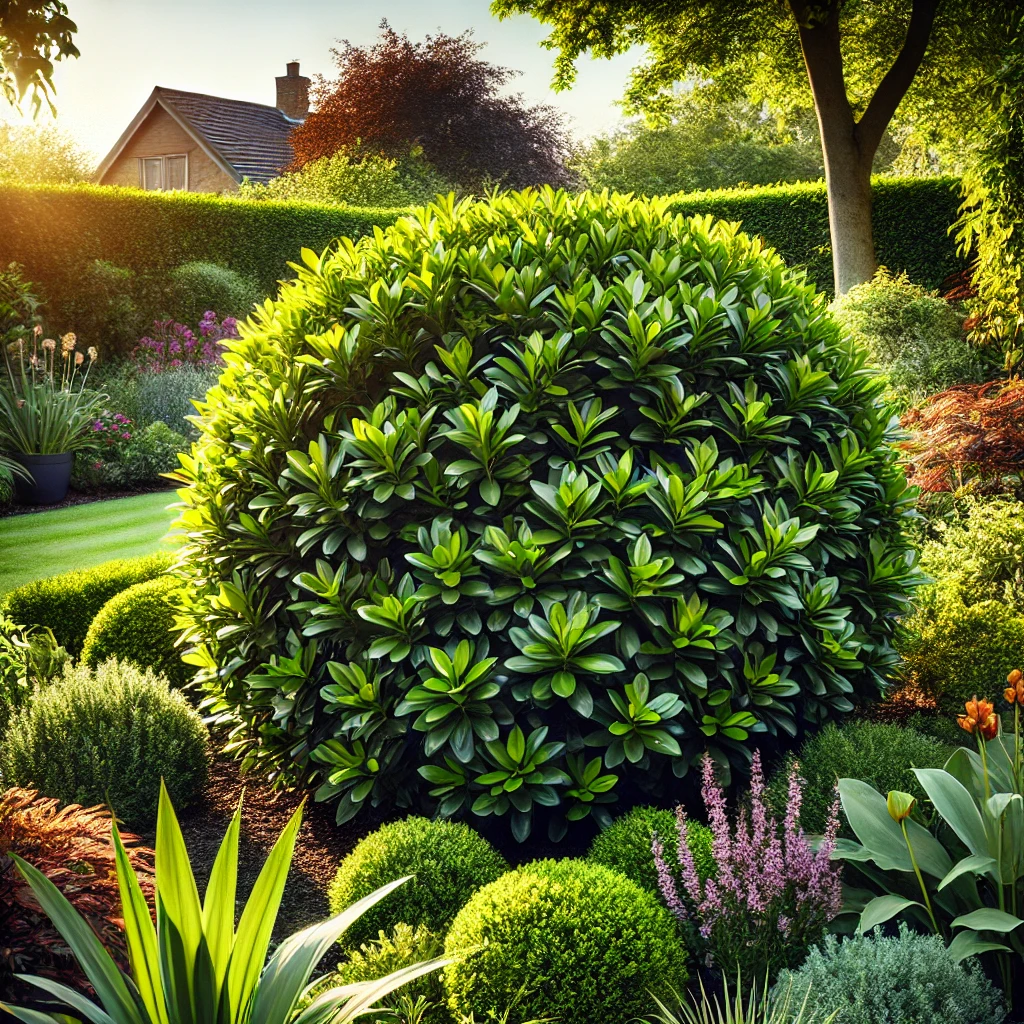
One of the first things you’ll notice about Griselinia is how vibrant its foliage is. Those glossy, bright-green leaves are hard to miss and create an eye-catching hedge that looks great year-round. Regardless of the season, this hedge remains green and lush, a blessing for those who dislike seeing a bare or dull-looking hedge in the winter.
When considering instant hedging NZ, having a hedge that looks good immediately and throughout the year is crucial, and Griselinia certainly delivers.
Now, let’s talk about why Griselinia makes an excellent instant hedge. For one, it grows quickly, like it’s got somewhere important to be. It’s not one of those slow-growing plants that tests your patience. Planted in the right conditions, Griselinia rapidly establishes itself, forming a dense hedge in a short time.
It’s perfect for anyone looking to add privacy or structure to their garden without the wait. Honestly, who has time to wait for a hedge to grow these days? With instant hedging becoming more popular in NZ, Griselinia steps up by providing immediate results.
But it’s not just about speed—it’s also about quality. This plant is incredibly low-maintenance, which is music to the ears of anyone who prefers to enjoy their garden rather than work in it every weekend.
Griselinia is tough, tolerating a wide range of conditions, from coastal environments to more sheltered inland gardens. Whether planted in windy areas or under full sun, Griselinia holds its own, making it a great choice for instant hedging NZ’s unpredictable weather.
Another standout feature of Griselinia hedges is their ability to be easily trimmed and shaped. Whether you want a neat, formal look or something more natural and relaxed, Griselinia is up for it. Its forgiving nature means you don’t have to worry about over-trimming—it’ll bounce back with new growth in no time.
This makes it a great option for those who aren’t hedge-trimming experts. Instant hedging that doesn’t require a green thumb? Yes, please!
Let’s not forget one of the best parts: when you choose Griselinia for instant hedging, you’re also getting a plant that complements other plants in your garden beautifully. Its neat, dense growth provides a perfect backdrop for flowering plants, adding elegance to any garden setting. When using the hedging Griselinia, it fits in so well that it sometimes feels like it’s been part of the garden forever, even when it’s newly planted.
Then there’s the convenience factor. If you order through Quickhedge, you can get mature Griselinia plants delivered and planted for just $45 each. It’s a no-brainer. There’s no waiting for years for the hedge to grow in—the mature plants are already on their way to giving you the privacy and beauty you desire.
Whether you’re creating a cozy garden nook or simply looking to block out the neighbors, these mature plants offer instant satisfaction. In the world of instant hedging in NZ, Griselinia shines.
In summary, Griselinia makes for an excellent instant hedge because it’s fast-growing, low-maintenance, and versatile enough to thrive in various conditions. It’s tough but beautiful, easy to trim, and fits effortlessly into almost any garden design. When looking for instant hedging in NZ, you can’t go wrong with Griselinia.
The fact that you can get mature plants delivered and planted for a fraction of the cost of more complicated landscaping solutions is just icing on the cake.
So, if you’ve got a space that needs a hedge or want a little extra privacy in your garden, Griselinia is the answer. It’s fast, reliable, and most importantly, instantly gratifying. Why wait for years when you can have a beautiful hedge right now? Let Griselinia do what it does best—make your garden look incredible, one glossy leaf at a time.
Creating A Wildlife Haven With The Hedging Griselinia
There’s something magical about a garden full of life: birds flitting between branches, butterflies dancing in the sunlight, and bees buzzing as they gather nectar—a hive of activity.
While many people think of flowers or ponds when considering a wildlife-friendly garden, there’s an unsung hero that can make a big difference: Griselinia hedge. Yes, hedging Griselinia is not just for privacy or aesthetics; it’s a haven for creatures like birds and beneficial insects.

Griselinia’s dense evergreen foliage makes it perfect for instant hedging NZ. It quickly establishes itself, providing shelter for small creatures. Birds, in particular, love it. They use the hedge for cover, nesting, and resting. A Griselinia hedge can turn your garden into a safe haven for birds, giving you the joy of watching and listening to their presence.
Its dense growth also attracts beneficial insects. Ladybugs, which prey on aphids, and hoverflies, which control pests, thrive in Griselinia hedges. This creates a healthy garden ecosystem. Insects like bees and butterflies use the thick structure of Griselinia for overwintering, and in return, they help pollinate your plants in spring, making Griselinia a vital part of a biodiversity-friendly garden.
Although Griselinia’s flowers aren’t flashy, they produce nectar that attracts bees and other pollinators, supporting your garden’s ecosystem. The hedge doesn’t just attract wildlife; it also provides year-round food for birds by hosting insects. In winter, when food is scarce, Griselinia helps sustain local bird populations.
Griselinia thrives in different climates, from coastal areas to windy or sheltered gardens, making it an ideal choice for instant hedging. It’s not just a pretty hedge; it supports an entire ecosystem. Even when you don’t see the wildlife, it’s there, benefiting from the food, shelter, and safety the hedge provides.
If you’re considering instant hedging NZ, Griselinia is a top choice. It grows fast, requires little maintenance, and attracts wildlife, making your garden both beautiful and functional. In a world where biodiversity is under threat, a Griselinia hedge can make a real difference. It’s more than a green wall—it’s a wildlife haven.
The Perfect Companion Plants For Your Griselinia Hedge
Griselinia hedges have become a gardener’s favorite, with their glossy, vibrant green leaves and dense growth providing a beautiful backdrop to any garden. But their beauty shines even more when paired with the right companion plants. Like a film with a great soundtrack, a Griselinia hedge looks its best when surrounded by plants that enhance its natural beauty.
So how do you choose the perfect Griselinia plant companions? It’s all about balance—finding plants that thrive in similar conditions, enhance the hedge’s look, and add interest to your garden.

Since Griselinia stays lush and green year-round, it serves as an excellent backdrop for plants that change with the seasons. You can play with color, texture, and height, knowing that your hedge will provide a consistent foundation. Flowering perennials can bring a pop of color at the base, while ornamental grasses add a flowing contrast to the hedge’s solid structure.
A Griselinia hedge often has a formal appearance due to their clean lines and dense foliage. But adding looser, more relaxed plants like lavender or rosemary can soften the hedge and create a natural, flowing design.
These aromatic plants not only thrive in similar conditions but also provide a sensory experience. Picture brushing past lavender while admiring your Griselinia hedge—your garden becomes a welcoming, lively space.
When choosing companion plants, consider the color palette. The rich green of the hedge pairs beautifully with harmonious shades like white or soft pastels. White-flowering plants like hydrangeas or gardenias add elegance, making the Griselinia hedge appear even more lush.
Alternatively, go bold with contrasting colors like deep purples or bright yellows. Plants like salvia or daylilies can create vibrant contrasts that stand out against the hedge’s glossy green leaves.
Texture also plays a key role in complementing your Griselinia hedge. Adding plants with varying textures can create depth and interest. Ornamental grasses like Miscanthus or Pennisetum offer feathery textures that contrast beautifully with the hedge’s smoothness. Ferns or hostas provide a soft, velvety texture, adding richness to the overall design.
It’s important to choose companion plants that thrive in similar conditions. Griselinia does well in well-drained soil with plenty of sunlight, so selecting plants like Hebe or Agapanthus, which prefer similar conditions, will ensure a harmonious garden. Ground covers like creeping thyme or Ajuga can create a soft transition from the base of the hedge, while mid-height plants like daisies or foxgloves can bridge the gap between lower and taller plants.
Designing a garden around a Griselinia hedge gives you flexibility. Whether you prefer a structured look or a more free-flowing garden, the right companion plants will accentuate the hedge and bring your garden to life. Many of these plants will also attract birds and beneficial insects, turning your garden into a thriving ecosystem.
In conclusion, pairing the right companion plants with your Griselinia hedge is about finding balance. By choosing plants that complement the hedge’s evergreen foliage, enhance its texture, and thrive in similar conditions, you can create a cohesive, vibrant garden.
Whether you prefer soft pastels, bold contrasts, delicate flowers, or bold grasses, there’s a perfect companion for every Griselinia hedge. So don’t just think of your hedge as a background feature—let it be the foundation for a stunning, dynamic landscape that brings joy to you and the wildlife it attracts.
How to Design a Low-Maintenance Garden with Griselinia Hedges
Low-maintenance gardens are the dream of anyone who enjoys nature’s beauty but doesn’t want to dedicate every weekend to gardening. The good news is that it’s entirely possible, and one of the best tools for a low-maintenance garden is the reliable Griselinia hedge.
With its durability, glossy green leaves, and easygoing nature, Griselinia provides structure and beauty to your garden without the need for constant care. If you’ve ever wanted a garden that looks well-maintained but requires minimal effort, Griselinia can make that dream a reality.
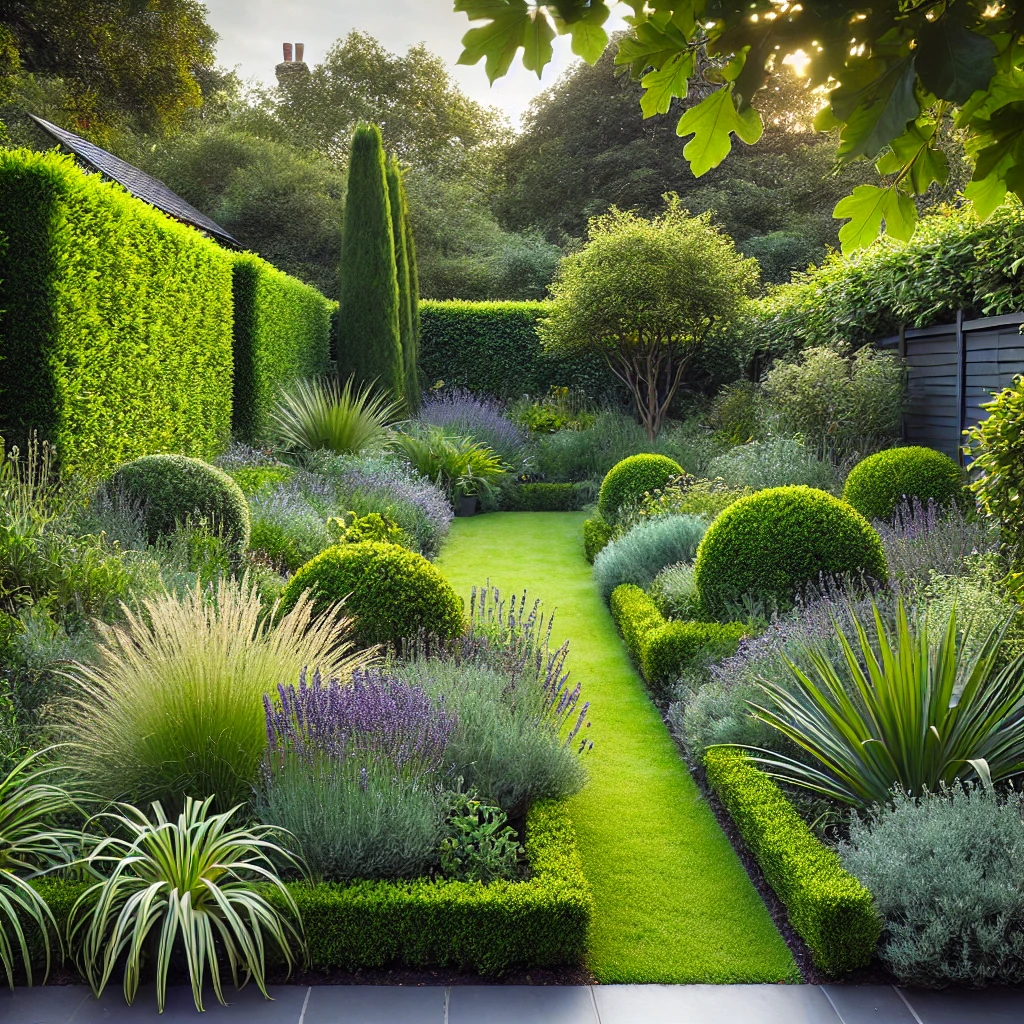
Griselinia hedges are ideal for creating boundaries or providing privacy without adding to your workload. One of its best qualities is that it’s evergreen—keeping its lush, green look all year long.
There’s no need to worry about bare patches or endless leaf raking. This year-round greenery ensures your garden remains beautiful with minimal seasonal fuss, meaning no big pruning sessions or replanting. A Griselinia hedge forms a green wall that holds its shape and color with just a bit of care.
Despite its attractive appearance, Griselinia is tough. It thrives in various conditions, including coastal environments, tolerating wind and salt spray. If you live near the coast or in an exposed area where other plants struggle, Griselinia won’t disappoint. It’s both sturdy and beautiful, making it the perfect ally for a low-maintenance gardener.
An essential element of low-maintenance garden design is selecting plants that don’t require frequent watering. Once established, the hedging Griselinia is drought-tolerant, meaning you won’t need to water it constantly.
In fact, the less you fuss over it, the better it grows—an ideal quality for a low-maintenance garden. During the initial planting phase, regular watering is necessary while the roots settle, but after that, it requires minimal attention.
A key part of low-maintenance garden design is ensuring plants work well together. Griselinia hedges provide a strong, evergreen structure to build around. It forms the backbone of your garden design, which can be complemented by other hardy, drought-resistant plants like lavender, rosemary, or ornamental grasses.
These plants, like Griselinia, thrive with minimal care, allowing you to enjoy your garden rather than work on it constantly.
Pruning is another area where Griselinia excels. Unlike hedges that require constant trimming, Griselinia grows at a manageable pace. A trim once or twice a year is enough to keep it looking neat and tidy, making it a self-sufficient plant that saves you time and effort.
When designing your low-maintenance garden with a Griselinia hedge, it’s important to think about placement. Griselinia prefers well-drained soil and full sun but can tolerate some shade.
Giving the hedge enough space to grow is crucial, as overcrowding can lead to uneven growth. Proper spacing ensures that your hedge grows evenly without requiring much intervention later on.
Another benefit of the hedging Griselinia is its versatility. Whether you prefer a formal, structured look with neatly trimmed hedges or a more natural, flowing design, Griselinia adapts beautifully. In formal gardens, it provides clean, crisp lines. In relaxed designs, its rich green leaves offer a soft, organic look. No matter how you choose to style your garden, Griselinia keeps things low-maintenance.
The key to a low-maintenance garden isn’t just in plant selection but also in how you arrange them. By using Griselinia as the foundation, you create a garden that looks lush and beautiful with minimal effort. Pair it with other tough, easy-care plants, and you’ve got a winning combination that lets nature do the hard work while you enjoy the view.
In the end, a low-maintenance garden doesn’t mean sacrificing beauty or interest. With the right plants, like Griselinia, you can have a stunning garden that’s easy to care for. You’ll spend less time on garden chores and more time relaxing among the greenery. So, if you want a garden that’s easy to maintain but still impresses, Griselinia is the way to go. It’s your secret weapon for a beautiful, low-maintenance garden.
Planting Griselinia – How To Choose The Right Size Griselinia Littoralis For Your Property
Now you have decided to plant that Griselinia hedge. Great choice! Native to New Zealand, this hardy hedge is not just beautiful but very practical while creating a natural boundary.
The tricky part would now be to determine what size of Griselinia littoralis you go for. Pretty much like buying shoes, it’s best to suit and fit while looking for the right one against the given space, purpose, and future plans.
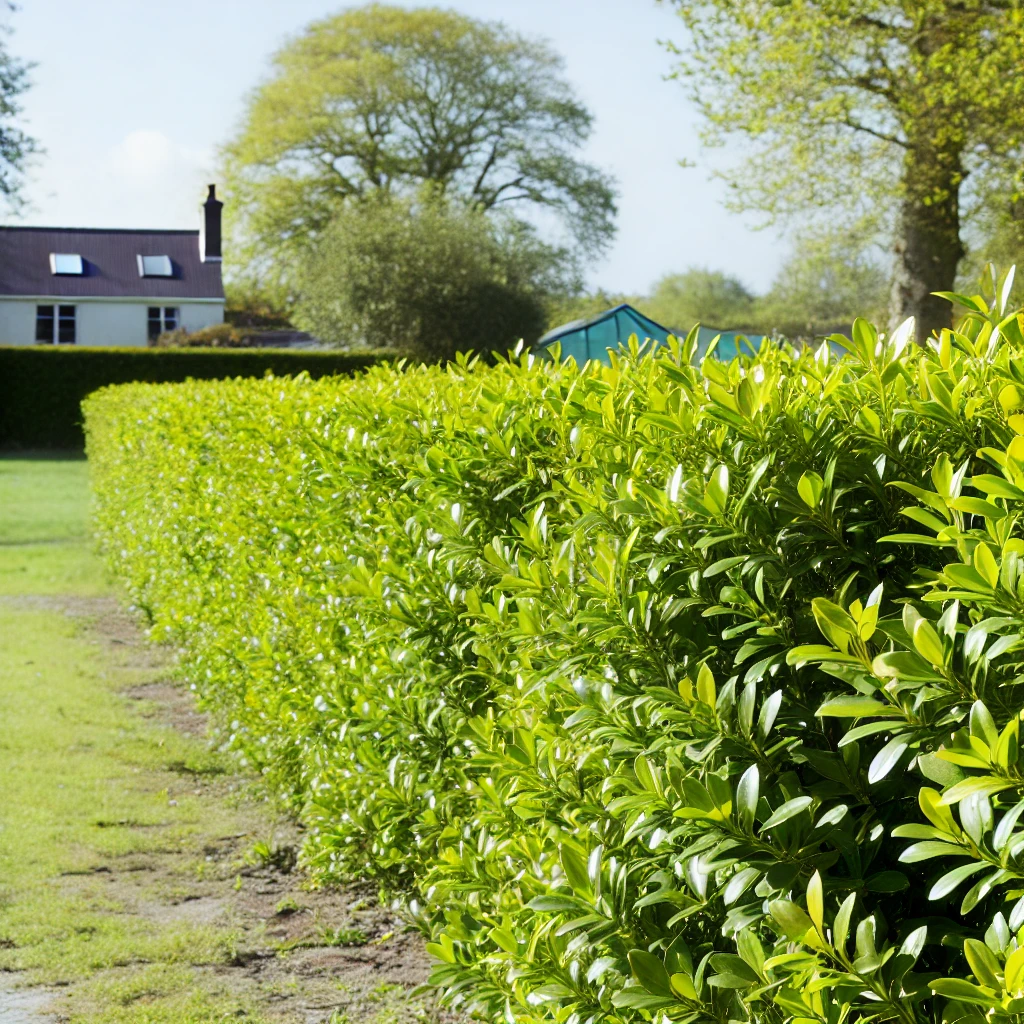
Understanding Griselinia Sizes
Griselinia plants obviously vary in size, from the very smallest to the very tallest, as do the customers who will be buying them. You can have one that is only about 300mm tall or one that is well over 1200mm.
The bigger the plant, the quicker you achieve the type of lush hedge you’re wanting; however, there’s more to it than just the speed of the hedge growing in. Let’s investigate what the factors are that will help you decide on which one is right for your property. Assess Your Property Size and Shape
First and foremost, take a good look at your property. A Griselinia littoralis hedge looks great in both big and small spaces, but the size of your property will play a major role in choosing the size of your plants. If you are working with a big and open area, it makes most sense to go with larger plants.
These taller specimens will give you a boundary fairly quickly and give your yard that enclosure you may want. Plus, you’ll get a good amount of privacy in a fairly short time. For smaller spaces, or if you’re more of a patient gardener, smaller Griselinia plants can be a better option.
They’re easier to manage in tight spots, and you can enjoy watching them grow over time. Plus, you’ll have more control over their shape as they mature, giving you that well-manicured look many hedge enthusiasts adore.
Budgetary Considerations
As with any garden project, money does matter.
Larger specimens of Griselinia obviously cost more outright. It’s the price one pays for speed-and let’s face it, most of us have been tempted to fork out that little bit extra to avoid waiting years for that “instant hedge” look. Smaller plants are cheaper and give you greater budgetary flexibility.
You can indulge in other garden supplies you may want, such as fancy compost or a new pair of gloves; one can never have too much of that.
Smaller plants do, however, require lots of care in their early days. Like toddlers in the garden world, they need much attention and from time to time TLC to grow up big and strong. Small Griselinia-hedged borders just might save your hedging budget if you’re up for the challenge.
Your Patience Level (Be Honest!)
That is when a little soul-searching is in order: are you an ‘instant gratification’ type of gardener who likes to plant something-say, today-and see results, like, yesterday? Or are you one laid-back type who is happy to plant a young hedge and then watch it grow over the next several years?
Larger Griselinia plants will give you a near-instant hedge, affording more immediate privacy and wind protection. But smaller plants allow you to bond with your hedge-yes, it’s a thing-nurturing it from sapling to a towering natural wall. Both options have real merit, but the choice needs to be based upon the level of patience and effort you are prepared to put into it.
Formal vs. Natural: The Final Look
Another consideration is the eventual appearance of your Griselinia littoralis hedge. Larger plants will inevitably give a much more formal, structural hedge sooner, so if you’re looking to achieve that nice clean line, these plants are the best solution.
More natural and softer hedges prefer smaller plants, which may suit the bill, allowing it to develop a bit freer in the initial years until they naturally firm up as they reach full development. A Griselinia littoralis hedge planted with smaller plants can also tend to feel more organically alive than a perfectly trimmed fence, which is great for those who like an organic look and feel.
Consider Local Conditions
Griselinia is hardy; it’s a plant nonetheless, and like all of us, it has its favorite setting. If you are in an exceptionally windy or exposed area, choosing the larger, more established plants makes much sense.
They will be better equipped to deal with harsh conditions and get established that much sooner. The smaller plants will be a bit more appreciative of protection and TLC until they get a good strong growth spur to take care of themselves in most weather conditions.
This is especially important if you are planting a hedge of Griselinia littoralis as a windbreak; it needs to be robust from day one bar you find yourself tending a bedraggled hedge more often than you’d ever like.
Conclusion
Ultimately, choosing the right size Griselinia for your hedge comes down to a combination of available space, budget, patience, and personal style. Whether you plant a row of small plants to watch grow over the years or go big with more mature specimens for an instant impact,
Griselinia littoralis is a great choice for any property. If you give it the right care and attention, your Griselinia hedge will reward you with lush, green foliage that should stand the wear and tear of time-and perhaps even your neighbor’s wandering eye.
Ready to pick your plants and get started with your Griselinia ? After all, hedging Griselinia is not all about creating a barrier; it’s about bringing beauty, value, and that little touch of nature to your property!
Fast-Track Your Privacy: Growing a Griselinia Hedge in Record Time
Hedge Your Bets on Fast-Tracking Your Privacy: Growing a Griselinia Hedge in Record Time
If you are one of those people who have ever had to bear with neighbors being a little too close for comfort, then you are not alone. The solution? A hedge. But not just any hedge—let’s talk about the superhero of hedges, that one called Griselinia littoralis.
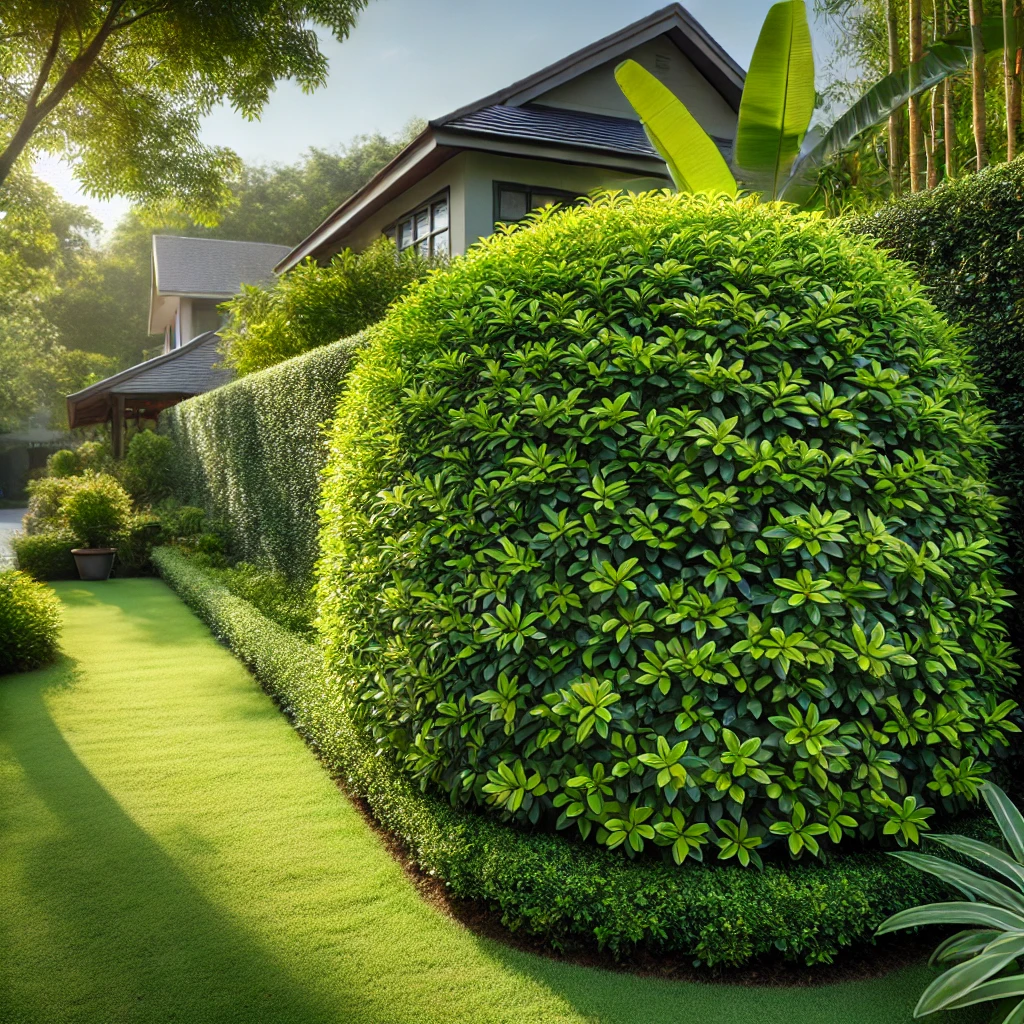
Known for its dense, evergreen foliage and rapid growth, this native New Zealand plant is the perfect candidate to fast-track your privacy.
With this article, we show you how you can get a Griselinia littoralis hedge off the ground and running in super-quick time.
Why Griselinia? Ideal Hedge Plant
Before we get into the mechanics of hedging, let’s just have a quick look at some of the many reasons why hedging Griselinia is such a good idea: Firstly, this plant is hardy and tough; it grows on a broad range of soils, and due to its salt tolerance, it is well adapted to coastal zones.
The second point is that it is a fast grower—just what you need when trying to create a screen against curiosity. Thirdly, it grows with these lush, green leaves—nice natural barriers that can block sight, wind, and noise.
Growth of a Griselinia littoralis hedge is all about understanding the potential that this plant shows and making the most out of it. By using the right techniques, your hedge will change from knee-high saplings into towering greenery in a very short period.
Planting for Success
First things first: spacing. There is the tendency to plant them close, but hold on just a minute! Proper spacing is necessary for the Griselinia hedge. Give them good space—about 500mm between plants. This gives them room to grow without competing for nutrients and water.
When planting, dig a hole roughly double the dimensions in size as the root ball of the plant. This will allow the roots room to splay comfortably and settle very quickly. Mix in some compost to give the plants a nutrient boost, and you’re already setting the stage for rapid growth. Planting in spring or early autumn is a good time for a Griselinia hedge, which enables one to avoid the searing summer heat and winter frost.
Watering Like a Pro
Watering is where most new hedge owners either go overboard or not enough. Here’s the deal: hedging Griselinia requires a good balance. While these plants are fairly drought-tolerant once they’re established, they require regular watering during their first year. The secret lies in keeping the soil moist but not waterlogged.
Overwatering results in root rot, whereas not putting enough water will ensure stunted growth for the plants.
Water deeply, less often. A good general rule is once or even less often, depending on your local climate. This encourages the roots to work their way down into the soil far more and in this long run will make your hedge hardier.
Feeding for Faster Growth
Griselinia littoralis hedge plants won’t fuss about food, but they do appreciate a nice meal. Feeding your hedge with a slow-release fertilizer in spring and again in summer really gives its growth rate a good kick. Use a balanced fertilizer—one that contains a decent amount of nitrogen, phosphorus, and potassium.
In addition to fertilizer, you might want to consider mulch around the base of your plants. Mulching will keep the soil temperature stable, retain moisture, and keep weeds at bay. It’s a great way to give your hedge that extra-neat, professional look—what’s not to love?
Pruning to Perfection
This may seem counterintuitive, but to get your Griselinia hedge to be thicker and faster-growing, pruning is very essential. Trimming the top growth during the first few years will indeed encourage lateral growth, filling out at the base of your hedge. This way, you won’t end up with just height and no width in the hedge.
Pruning is best done in late winter or early spring, before growth starts. Go easy on the trimming—no need to go full Edward Scissorhands here. A light touch will suffice to keep a healthy and dense hedge.
Protecting Your Investment
While Griselinia is hardy, it is not indestructible, so watch for such pests as aphids or scale. These tiny intruders steal the sap from plants, which can bring about a slowing of growth in your hedge. If you find them, a quick spray with insecticidal soap should do the trick.
Another important aspect to watch out for is poor drainage. Griselinia does not enjoy wet feet; therefore, the drainage of your soil needs to be good. If you notice water gathering around the base of your plants post-rain, consider enhancing drainage by mixing sand or gravel into the soil.
Patience, Young Grasshopper!
Yes, Griselinia is a fast-growing plant, but let’s not get ahead of ourselves here—Griselinia hedging is not an overnight miracle worker. With good care, you can expect your Griselinia littoralis hedge to grow about 30-60cm per year. That means in several short years, you will have a full-blown hedge giving you the privacy, windbreak, and noise reduction you want.
Follow these tips, and your hedge will be off in no time. Block out nosy neighbors, or create a peaceful green space for yourself; hedging Griselinia is the fast, effective earth-friendly solution you’re looking for. Soon, you will be seeing a Griselinia hedge in no time, just having your shovel, compost, and a sense of humor.
Hedging With Griselinia – Using Instant Hedging For Fast Privacy
Griselinia is the unsung hero when it comes to creating a private oasis in your garden. Divulging oneself from nosy neighbors, or just creating a green, serene space where one can relax, a Griselinia hedge does it perfectly.
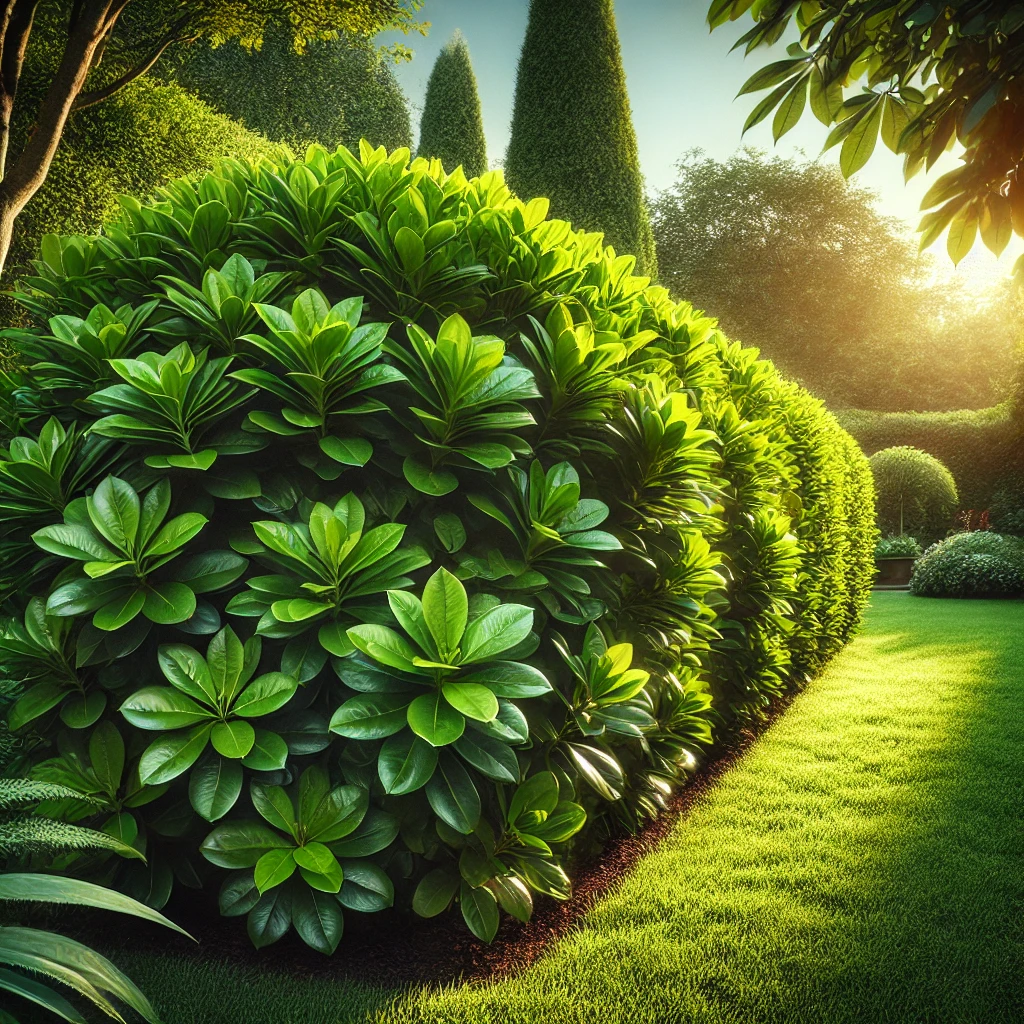
It is fast-growing, hardy, and dense, hence becoming the top choice for any kind of instant hedging needs. Let’s take an in-depth look as to why Griselinia is the go-to plant for privacy and how instant hedging can transform your outside space both quickly and effectively.
Why Griselinia?
But Griselinia isn’t just another hedge plant, it’s a superstar in the world of hedging. This evergreen beauty originates from New Zealand, which essentially means it is built tough.
Griselinia is tolerant of coastal winds, frost, and even drought; thus, it is one of the hardiest hedge plants you will ever find. Its leaves are a brilliant green color, thick, and glossy; hence, they create a very dense screen, which is very good for privacy.
It also isn’t fussy about its soil type-meaning whether your soil is on the sandier side or richer, it will be okay. And the best: Griselinia is a fast grower. You may be one of those impatient kinds-aren’t we all when we want to shut the world out-so you may like to know that with favorable conditions, a Griselinia hedge can grow up to 60 centimeters per year.
That’s right, in only a couple of years you can go from feeling exposed to enjoying the lush privacy that only a Griselinia hedge can provide.
The Instant Hedging Solution
Instant hedging can be a real game-changer for those of us who wanted privacy since yesterday. You could say that getting an instant hedge of Griselinia in some way gives you a head start on your dream garden, as you are not planting these small, prima-donna plants that grow at the speed of a tortoise, but real, grown mature plants which are way into forming a thick hedge.
It’s the equivalent of ordering a pizza for delivery rather than making one from scratch-you get a lot quicker results with far less effort.
Using instant hedging saves time, but it also gives a far more complete and polished finish. Whether you want to enclose your front yard and block off the driveway or provide a screen for your patio area in the back, this gets done in no time with Griselinia instant hedging.
How Instant Hedging Works
You may wonder how this magic of instant hedging works. It is quite simple, really. Instead of buying very small plants in pots, which will need to grow slowly over time, with instant hedging, you purchase hedging Griselinia plants that are already grown to a height that affords you immediate coverage.
These plants are tenderly grown by the nurseries and ready for planting directly in your garden.
Planting instant Griselinia hedging is relatively easy. You shall have to prepare the ground for it, by ensuring that it is weed-free and the drainage is good; other than that, it is just a question of digging a trench for placing the plants in and backfilling with soil. Your instant hedge will thrive once you give it that bit of water and care and attain that much wanted privacy in record time.
Why Choose Griselinia for Instant Hedging?
There are a lot of fantastic reasons why Griselinia is perfect for instant hedging. First of all, it’s very low maintenance. Once your Griselinia hedge is well established, you won’t need to do much other than give it the occasional light trim to keep it looking neat.
For those of us who love the idea of a lush hedge yet aren’t too keen on the constant pruning and caring that comes with it, this plant is ideal.
Added to this, Griselinia is an environmentally friendly option. Its dense foliage provides not only a screen against the line of sight but also noise reduction and can even filter out pollutants, making it an ideal plant for homes that are on busy roads or in urban settings. And handsome to boot.
Shiny green leaves, compact growth habit-a Griselinia hedge adds that fresh, vivid touch in any garden, not just a screen for privacy but also a stylish section of hedge.
Conclusion
Hedging with Griselinia will provide the quick, effective, and lovely solution to your privacy needs. Instant hedging takes the guesswork out and makes the waiting game a thing of the past so that you may have a full, lush hedge from the get-go.
Whether trying to create a private garden retreat or take unwanted views out of sight, a Griselinia hedge will deliver. So, why wait for years when you can have instant results? With Griselinia, your dream of a private, green paradise is just a few steps — and plants — away.
Griselinia Hedging: Common Misconceptions About Griselinia Die Off
Griselinia hedges are one of the most popular plants, which people desire to grow for an evergreen full screen for privacy. Known to many for being quite hardy, bright green in foliage, and fast-growing, Griselinia is often the ‘go-to’ plant if one desires an easy hedge to maintain.
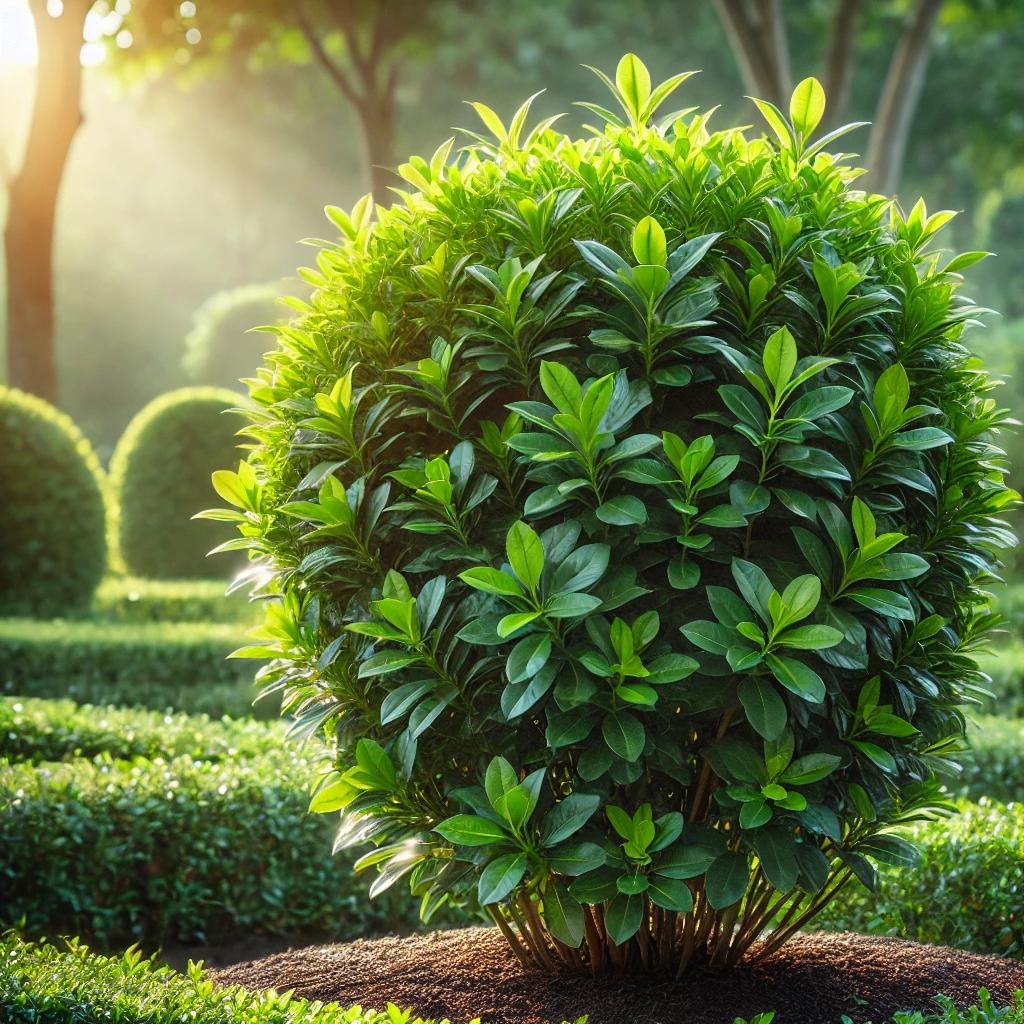
Then, there’s this whisper from time to time about “Griselinia die-off” which instills fear into the heart of proud hedge owners. But is this really something to worry about, or just another garden myth? Let’s deal with some of the common misconceptions about Griselinia die-off and get to the root of the issue—pun intended.
Myth #1: Griselinia Die-Off Is Inevitable
Seemingly, one of the biggest number of fears about Griselinia hedging can be that die-off is inevitable. Some gardeners do feel that no matter what, their beautiful Griselinia hedge will always die a sad death.
This couldn’t be further from the truth! hedging Griselinia is, in reality, a robust, hardy plant that grows impressively in quite a few settings, including coastal areas and inland gardens. There are an array of conditions under which your Griselinia hedge can be stressed, but with good care and some attention, it will be happy and healthy for years to come.
Myth #2: Griselinia Hates Wet Feet
Another big myth is that Griselinias do not like wet soils, period. Admittedly, definitely too wet and waterlogged conditions can cause root rot, a common cause of dieback. This does not mean your Griselinia hedge will keep on wilting at the very first sign of moisture. Griselinia can handle a reasonable amount of moisture, as long as it isn’t sitting in a soggy swamp.
The trick is to plant your hedge in well-draining soil, and have good airflow around the roots. If your garden is prone to becoming a bog in heavy rain, consider improving the drainage in that area to give your Griselinia a fighting chance.
Myth #3: Griselinia Is Disease-Prone
It is easy—the day something like Griselinia has a bad day, if you see what I mean—to assume that it is suffering from some sort of mysterious hedge-eating disease. In truth, Griselinia is not especially prone to disease.
Most die-off is due to environmental factors and not some underlying disease. For instance, a drought, poor soil conditions, and even improper planting can cause stress to a Griselinia hedge and cause it to look diseased or die off.
Obviously, the best course to get your hedge off right in the first place is well-prepared soil and water during dry spells. Trust me, it’s not out to catch a cold.
Myth #4: All Hedges Die in Winter
Some may think that Griselinia cannot tolerate cold winters, but it is a big misconception. While Griselinia could shed a few leaves during really inclement weather, generally, it is quite tolerant of the cold.
As a matter of fact, Griselinia is one of the most hardy options available for hedging. Just plant it in an area not specifically exposed to icy winds, take good care of the tree, and your Griselinia hedge will remain green during winter.
Conclusion: Do Not Fear the Die-Off!
Hedging with Griselinia provides gardeners who need a lush, screening type of plant an extremely low-maintenance and often effective privacy screen. Although there are some misconceptions regarding Griselinia die-off, this robust plant will be just fine with the right tendering.
Make sure you plant in the right conditions, provide drainage appropriately, and take notice of the soil moisture, and your Griselinia hedge will reward you with years and years of beautiful, green cover. The next time you hear someone whispering to you about Griselinia die-off, you will be able to confidently set the record straight.
After all, a well-cared-for Griselinia hedge is not only a thing of beauty, but it’s here to stay!
Griselinia – The Huge Benefits of Growing a Griselinia Hedge for Privacy
Imagine stepping out into your garden and being greeted by a lush, green wall of natural beauty, offering complete privacy and a sense of tranquility. This isn’t just a gardener’s dream—it’s the reality of growing a Griselinia hedge. Known for its vibrant foliage and hardy nature, the Griselinia littoralis, often called the New Zealand Broadleaf, is a top choice for those seeking a natural solution to privacy in their outdoor spaces.
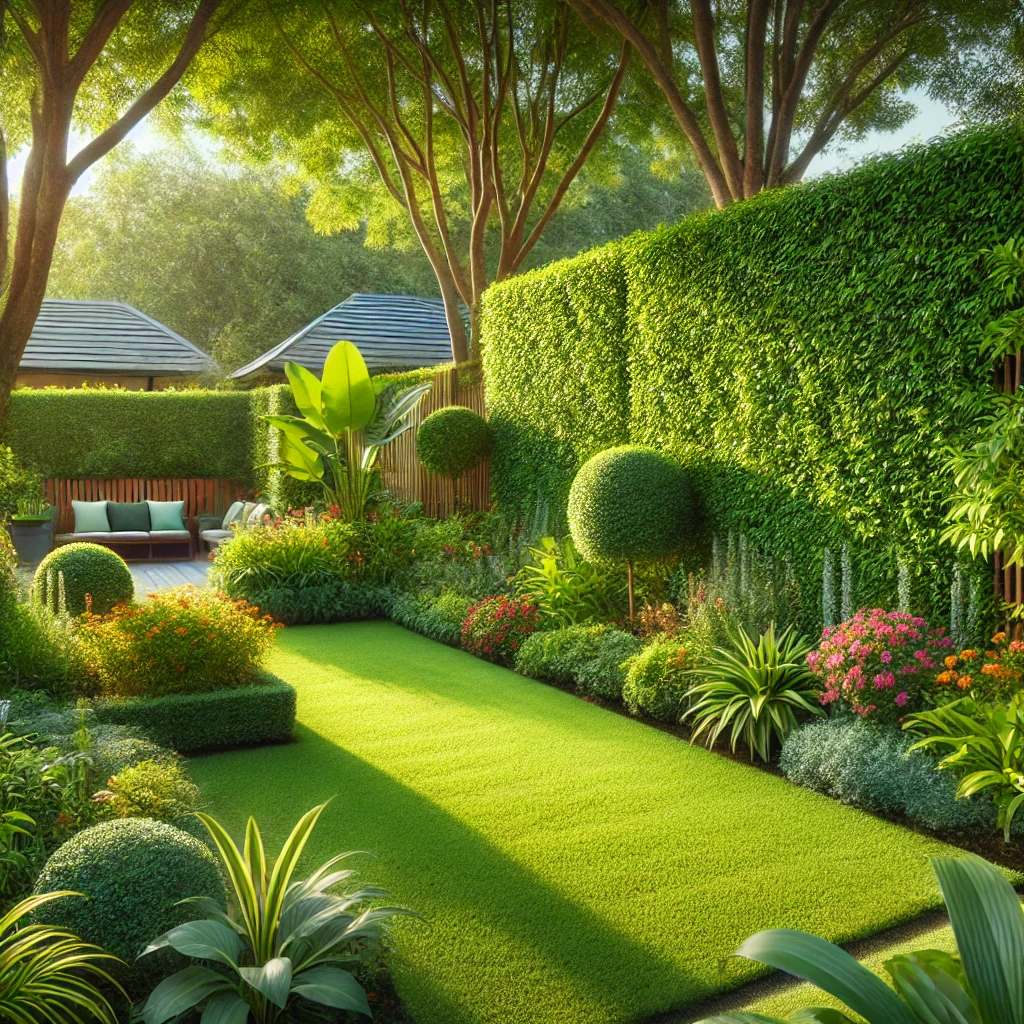
Why Choose Griselinia for Privacy?
Privacy is a luxury many of us crave, especially in an age where homes are built closer together and outdoor spaces feel more exposed. Fences can do the job, but they often lack the charm and natural beauty of a living hedge. Griselinia hedges offer a perfect blend of function and aesthetics. With their dense foliage and ability to grow quickly, they create an effective barrier that’s both visually appealing and incredibly practical.
Let me tell you about my own experience. A few years ago, I moved into a house where the backyard felt like it was part of the neighbor’s patio. Every time I stepped outside, I felt like I was on display. Installing a fence seemed too harsh for the serene vibe I wanted. That’s when I discovered Griselinia.
The Beauty of Griselinia
One of the standout features of a Griselinia hedge is its bright, glossy green leaves. Unlike some hedging plants that can look dull or sparse, Griselinia brings a sense of vibrancy to your garden all year round. Even in the depths of winter, this evergreen hedge provides a stunning backdrop to any outdoor space.
Its versatility is another reason it’s so popular. Whether you want a hedge that’s neatly trimmed for a formal look or prefer a more natural, relaxed vibe, Griselinia adapts effortlessly. In my case, I opted for a structured look, and with a bit of regular trimming, it transformed my backyard into a private haven that even my neighbors admired.
Speedy Growth for Instant Results
One of the frustrations with hedges is waiting for them to grow. Griselinia, however, is a fast grower, making it perfect if you’re eager for privacy. With proper care and the right conditions, it can grow up to 30-50 centimeters a year. Within just a couple of seasons, my once-exposed yard became a secluded oasis.
If you’re starting with young plants, you can speed up the process by planting them close together—around 50 centimeters apart is ideal. Water them regularly, especially during the first year, and watch as they quickly fill out to form a dense wall of greenery.
Low Maintenance, Big Rewards
I’ll admit, I’m not the most diligent gardener. I wanted a hedge that would thrive without constant attention, and Griselinia delivered. It’s incredibly low maintenance, requiring only occasional trimming to keep its shape. Even during hot, dry summers, it stayed lush and healthy with minimal watering.
Another bonus? Griselinia is surprisingly resistant to pests and diseases. Unlike some plants that need regular treatments to keep them looking good, this hedge is naturally robust, which makes it a favorite among both seasoned and novice gardeners.
A Green Alternative to Fencing
There’s something deeply satisfying about creating a boundary with living plants rather than relying on artificial barriers. Not only does a Griselinia hedge add beauty and character to your property, but it also benefits the environment. It provides habitat and shelter for birds, insects, and other wildlife, contributing to a healthier ecosystem in your garden.
For instance, I’ve noticed that since planting my hedge, birds often nest there, adding life and movement to my backyard. It’s a reminder that privacy doesn’t have to come at the cost of nature—it can enhance it.
Practical Tips for Growing a Griselinia Hedge
- Location Matters: Griselinia thrives in sunny or partially shaded areas. It’s tolerant of a wide range of soils but prefers well-drained conditions.
- Water Wisely: Regular watering is crucial during the first year to help the hedge establish its roots. After that, it becomes more drought-resistant.
- Prune for Perfection: Trim your hedge at least once a year, preferably in late spring or early summer, to maintain its shape and encourage dense growth.
- Feed for Success: A slow-release fertilizer applied in spring can give your hedge a boost, ensuring it stays vibrant and healthy.
Transform Your Space with Griselinia
Growing a Griselinia hedge for privacy isn’t just about creating a barrier—it’s about transforming your outdoor space into a peaceful retreat. Whether you have a sprawling garden or a compact yard, this versatile and beautiful plant has the power to elevate your surroundings and give you the seclusion you crave.
For me, planting a Griselinia hedge wasn’t just a gardening project; it was an investment in my home and my peace of mind. Every time I step into my backyard now, I feel like I’m in my own private sanctuary, shielded from the world by a wall of vibrant green. If you’re looking for a natural, effective, and stunning solution for privacy, you can’t go wrong with a Griselinia hedge.
The Origins of Griselinia
Griselinia, with its lush, glossy foliage and versatility, is a favorite among gardeners worldwide. But have you ever stopped to wonder where this remarkable plant comes from? Its origins are as fascinating as the hedge itself, with deep roots in the natural history of New Zealand and South America.
Exploring the story of Griselinia is like peeling back the layers of an ancient mystery, revealing how this plant evolved to thrive in diverse environments and eventually found its way into our gardens.
Let’s start in New Zealand, where Griselinia littoralis, often referred to as the New Zealand broadleaf, dominates coastal and forest landscapes. This evergreen is part of a unique lineage of plants that evolved millions of years ago, back when New Zealand was part of the supercontinent Gondwana.
Picture this: dense prehistoric forests filled with towering trees and underbrush, where early forms of Griselinia grew, adapting to thrive in the wild, rugged terrain. As Gondwana began to break apart, species like Griselinia remained isolated in New Zealand, evolving independently into the robust plants we know today.

Griselinia’s story doesn’t stop there. A lesser-known species, Griselinia lucida, also native to New Zealand, paints a different picture of survival. This plant often grows epiphytically, meaning it thrives perched high on other trees, clinging to cliffs, or nestled into rocky crevices.
Imagine standing in a New Zealand forest and looking up to see a vibrant green plant growing in what seems like an impossible spot. This adaptability speaks to the resilience of the genus and hints at why Griselinia has become such a popular choice for modern gardeners.
My first encounter with Griselinia was during a trip to New Zealand. I remember walking along a coastal trail, marveling at the plants that seemed to thrive despite the salty sea air and strong winds.
There, standing strong against the elements, was a Griselinia hedge. Its leaves were a vibrant green, shining in the sun as if untouched by the harsh conditions. I was struck by its beauty and toughness a combination that’s rare in the plant world. I knew then and there that this was a plant I wanted in my own garden.
Interestingly, Griselinia isn’t limited to New Zealand. The genus has another home across the Pacific, in South America, where species like Griselinia scandens thrive. These plants have their own unique adaptations, having evolved in entirely different environments, from the humid forests of Chile to the rocky Andean slopes.
This dual heritage makes Griselinia a truly global genus, with a foot in two continents and a history that spans millions of years.
When you bring a Griselinia plant into your garden, you’re not just planting a hedge; you’re cultivating a piece of botanical history. The New Zealand species, particularly Griselinia littoralis, is cherished for its fast growth, dense foliage, and ability to handle everything from frost to drought.
These traits have made it a staple in gardens across the globe, where it’s used to create privacy, windbreaks, and even decorative borders.
In my own backyard, Griselinia littoralis has become a centerpiece. When I first planted it, I was nervous. Would it grow as beautifully as the hedges I’d seen in New Zealand? But with a little care, regular watering during its first year and occasional pruning to encourage bushy growth it exceeded my expectations. Today, it stands as a living wall of green, providing shade, privacy, and a sense of tranquility that no fence could ever match.
One of the most striking aspects of Griselinia is how effortlessly it bridges the gap between utility and beauty. It’s no wonder that this plant has captured the hearts of gardeners and landscapers alike. Whether you’re planting it to create a serene backyard retreat or to shield your home from prying eyes, Griselinia delivers on every front.
The next time you admire a Griselinia hedge, take a moment to appreciate its origins. This plant has traveled through time and space, adapting and thriving across continents, before becoming the garden staple we know today. Its journey from the ancient forests of Gondwana to modern-day backyards is a testament to nature’s resilience and ingenuity.
So, the next time you’re searching for a hedge that offers privacy, beauty, and a touch of history, consider Griselinia. Not only will you have a stunning addition to your garden, but you’ll also be nurturing a plant with a story as rich and vibrant as its leaves.
Whether you’re in a coastal town battered by salty winds or a quiet inland suburb, Griselinia will thrive, bringing a little piece of New Zealand or South America into your corner of the world.
Pro Tips – How To Maintain A Healthy Griselinia Hedge
A well-maintained Griselinia hedge can transform your garden into a lush, private oasis. Its dense, glossy foliage makes it a favorite for creating natural boundaries, offering both beauty and functionality.
But like all plants, a Griselinia hedge requires care and attention to thrive. Whether you’re a seasoned gardener or a first-time hedge owner, maintaining a healthy Griselinia hedge is simpler than you might think when you know the right tips and tricks.
I remember when I planted my first Griselinia hedge. I’d just moved into a home with a wide, open backyard that felt more like a fishbowl than a sanctuary. Privacy was my top priority, but I also wanted something that would bring a bit of life and greenery to the space.
A friend recommended Griselinia, describing it as hardy, fast-growing, and easy to maintain. I decided to give it a try, and years later, it remains one of the best decisions I’ve made for my garden.
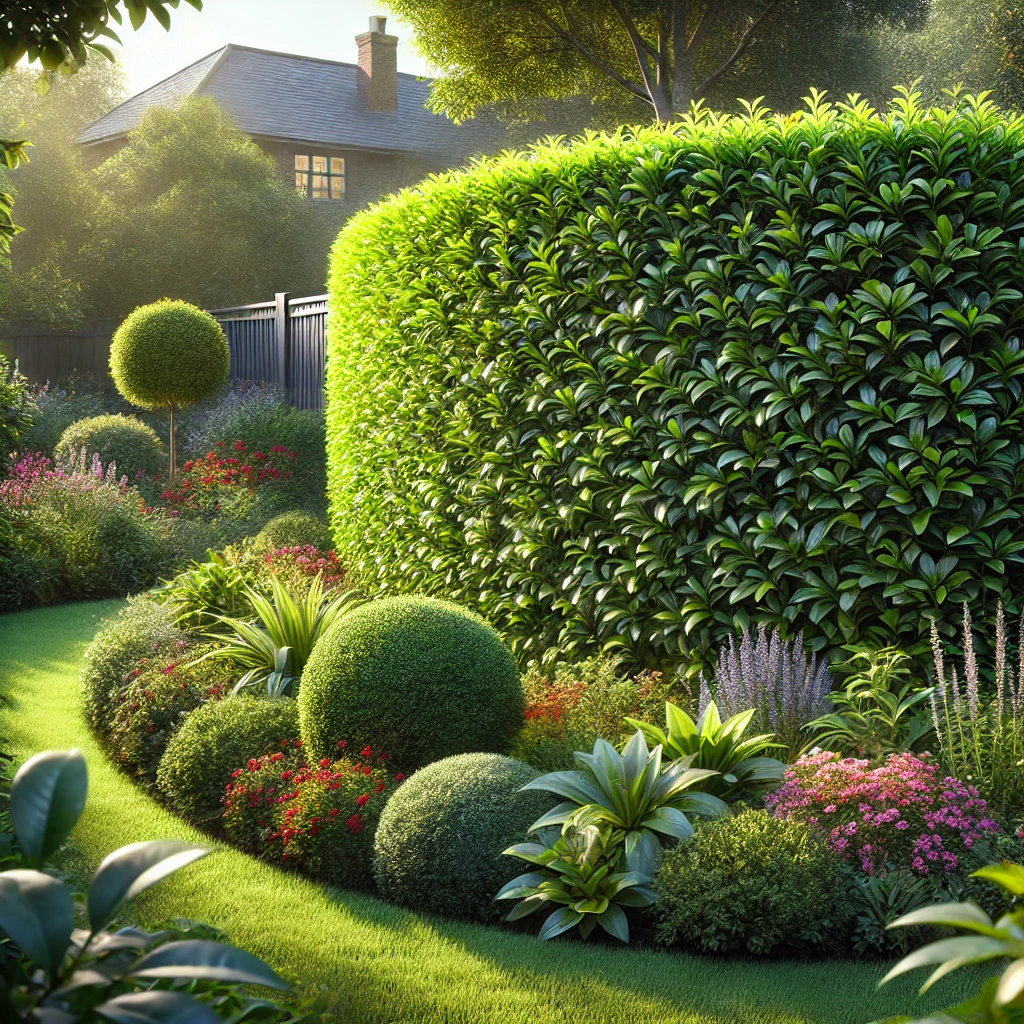
The first step to maintaining a healthy Griselinia hedge is understanding its needs. Griselinia thrives in well-drained soil and enjoys a sunny or partially shaded spot. If you’ve just planted your hedge, the initial few months are crucial.
Watering regularly is essential, especially during dry spells, to help the young plants establish strong roots. In my experience, a drip irrigation system can work wonders, ensuring the soil remains consistently moist without waterlogging it.
Feeding your Griselinia hedge is another important aspect of care. Like any plant, it needs nutrients to grow strong and vibrant. I like to use a slow-release fertilizer in early spring, just as the growing season begins.
This gives the hedge a nutrient boost that lasts for months, promoting healthy growth. Every few years, I also add a layer of compost around the base of the plants. Not only does this enrich the soil, but it also helps retain moisture, which is especially useful during the hotter months.
Pruning is where many hedge owners get nervous, but it’s simpler than it seems. Regular pruning not only keeps your hedge looking neat but also encourages denser growth, which is ideal for privacy. I usually trim my Griselinia hedge twice a year, once in late spring and again in early autumn.
The key is to use sharp, clean tools and avoid cutting too deeply into the older wood, as this can leave the hedge looking sparse. Instead, focus on shaping and tidying the outer edges. Over time, you’ll get a feel for how your hedge grows and how much you can trim without compromising its health.
One summer, I made the mistake of over-pruning during a particularly hot week. The exposed branches suffered sunburn, and the hedge took months to recover. Since then, I’ve learned to prune during cooler parts of the day and to leave enough foliage to protect the plant. It’s little lessons like these that make all the difference in hedge maintenance.
Another challenge I’ve encountered is pest management. While Griselinia is relatively pest-resistant, it’s not immune. Aphids and scale insects can sometimes make an appearance, especially if the hedge is under stress. The best defense is a healthy plant, so regular watering, feeding, and pruning are your first line of defense.
If pests do appear, a simple solution of soapy water sprayed on the affected areas can often do the trick. For more persistent issues, I’ve found natural insecticides to be effective without harming the beneficial insects that visit the garden.
Weather can also play a role in the health of your Griselinia hedge. Heavy winds, frost, and drought can all take their toll. Living in a windy area, I’ve had to stake a few young plants to keep them upright until their roots were strong enough to anchor them.
In colder climates, a layer of mulch can help protect the roots from frost, while watering deeply but less frequently during droughts can encourage the roots to grow deeper and find moisture.
Lastly, don’t underestimate the power of observation. Spend time with your hedge, yes, I mean it! Walk along its length every few weeks, checking for signs of stress, disease, or pests. This proactive approach has saved me countless times. Early intervention is much easier than trying to fix a problem once it’s taken hold.
A healthy Griselinia hedge doesn’t just happen overnight. It’s the result of consistent care and a little bit of patience. Over the years, I’ve come to see my hedge as more than just a privacy barrier. It’s a living, breathing part of my garden that provides shade, shelter for birds, and a beautiful backdrop for everything else I’ve planted.
If you’re considering a Griselinia hedge or already have one, trust me it’s worth the effort. With regular care, it will reward you with vibrant, dense foliage that enhances your garden and gives you that sense of seclusion we all crave in our outdoor spaces.
So roll up your sleeves, grab your gardening tools, and enjoy the process of nurturing this incredible plant. You won’t regret it.
How Does a Griselinia Hedge Improve Your Local Ecosystem?
When people think of a Griselinia hedge, they often picture its neat, lush appearance and its ability to provide privacy and aesthetic appeal. But there’s so much more to this plant than meets the eye.
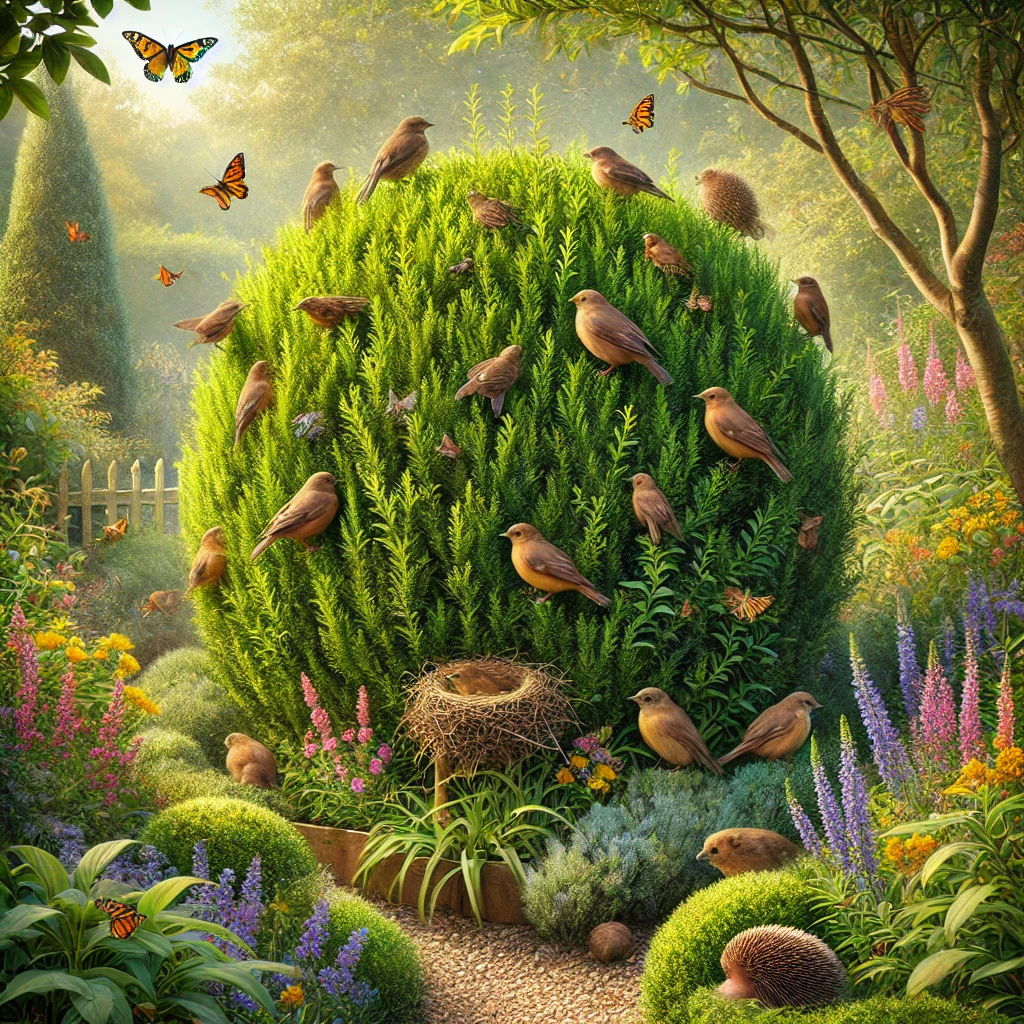
Beyond its beauty and practicality, a Griselinia hedge can play a vital role in improving your local ecosystem. By planting and maintaining a Griselinia hedge, you’re not just enhancing your garden—you’re making a positive impact on the environment around you.
I first planted my Griselinia hedge years ago, simply to create a natural boundary for my property. What I didn’t anticipate was how quickly it became a haven for wildlife and an integral part of my garden’s ecosystem. Over time, I realized that this humble hedge was doing more for the environment than I could have imagined.
One of the most significant ways a Griselinia hedge improves your local ecosystem is by providing habitat and shelter for wildlife. Its dense foliage is perfect for birds, small mammals, and insects seeking refuge. I remember one spring morning when I noticed a pair of blackbirds busily nesting within my hedge.
Watching them raise their chicks was a heartwarming reminder of how even a simple hedge can support life. The hedge also became a stopping point for bees and butterflies, drawn to the nearby flowers I’d planted. It wasn’t long before my garden buzzed with activity, transforming into a mini wildlife sanctuary.
Another benefit of a Griselinia hedge is its ability to stabilize the soil. This plant’s strong root system helps prevent erosion, especially in sloped or exposed areas. In my own garden, there’s a slight incline where heavy rains used to wash away the soil, leaving unsightly patches and weakening other plants.
Since planting the hedge along the base of the slope, I’ve noticed a dramatic improvement. The soil stays put and the hedge itself seems to thrive on the challenge.
Griselinia also contributes to air quality and carbon sequestration. Like all plants, it absorbs carbon dioxide and releases oxygen through photosynthesis, helping to clean the air. Its evergreen nature means that it performs this role year-round, unlike deciduous plants that lose their leaves in winter.
I’ve always appreciated how fresh and crisp the air feels around my garden, especially on a breezy day. Knowing that my hedge plays a small part in improving air quality makes maintaining it all the more rewarding.
Water management is another area where a Griselinia hedge can shine. Its roots absorb water, reducing runoff and helping to manage moisture levels in your garden. After a particularly rainy season, I noticed that the areas near my hedge were less prone to puddles compared to spots without much vegetation. The hedge seemed to act like a natural sponge, soaking up excess water and preventing it from pooling or causing damage.
In addition to these practical benefits, a Griselinia hedge supports biodiversity by creating a microhabitat. The mix of wildlife it attracts helps maintain a healthy balance in the garden ecosystem. For instance, birds nesting in the hedge feed on insects, which naturally keeps pest populations under control.
I’ve also spotted ladybugs and spiders, both of which are fantastic allies in managing garden pests. The hedge isn’t just a barrier; it’s an active participant in the life of the garden, contributing to its overall health.
Planting a Griselinia hedge can also have a ripple effect in your local community. When neighbors see the positive impact your hedge has on the environment, they may be inspired to plant their own. Over time, this can create green corridors that connect different properties, allowing wildlife to move freely and safely.
I’ve had several conversations with neighbors who were curious about my hedge and decided to plant their own after seeing how vibrant and full of life my garden had become.
Maintaining a healthy Griselinia hedge is key to reaping its environmental benefits. Regular pruning keeps the foliage dense, which is essential for providing shelter and maintaining its aesthetic appeal. Adding organic mulch around the base not only nourishes the soil but also supports beneficial microorganisms.
Watering during dry spells ensures the hedge continues to thrive, supporting the ecosystem it nurtures.
In the years since I planted my Griselinia hedge, it has become much more than a simple garden feature. It’s a living, breathing part of the environment that contributes to the well-being of my local ecosystem.
From providing habitat and stabilizing soil to improving air quality and supporting biodiversity, this hedge has proven its worth time and again. And perhaps the most rewarding part is knowing that something as simple as planting a hedge can have such a profound impact on the world around us.
If you’re considering planting a Griselinia hedge, know that you’re not just making a choice for your garden you’re making a choice for the planet. With every leaf, root, and branch, this incredible plant has the power to transform your space into a thriving ecosystem, one that benefits not only you but also the countless creatures that call it home.
So go ahead, plant that hedge, and watch as it becomes a cornerstone of your local environment.
From Privacy to Beauty: Unlocking the Potential of Griselinia
Griselinia, with its lush, glossy green foliage and versatile nature, has become a favorite for gardeners looking to combine beauty and practicality. Whether you’re aiming to create a secluded retreat, define your garden boundaries, or simply add a touch of elegance to your outdoor space,
Griselinia offers endless possibilities. Its ability to thrive in various conditions, paired with its stunning aesthetics, makes it a plant that can do far more than just provide privacy.
When I first planted Griselinia in my garden, I was focused on its functionality. My backyard was too exposed for comfort, and I wanted a natural way to create a sense of seclusion. I wasn’t interested in the harsh lines of a fence or wall I wanted something that felt alive and connected to nature.
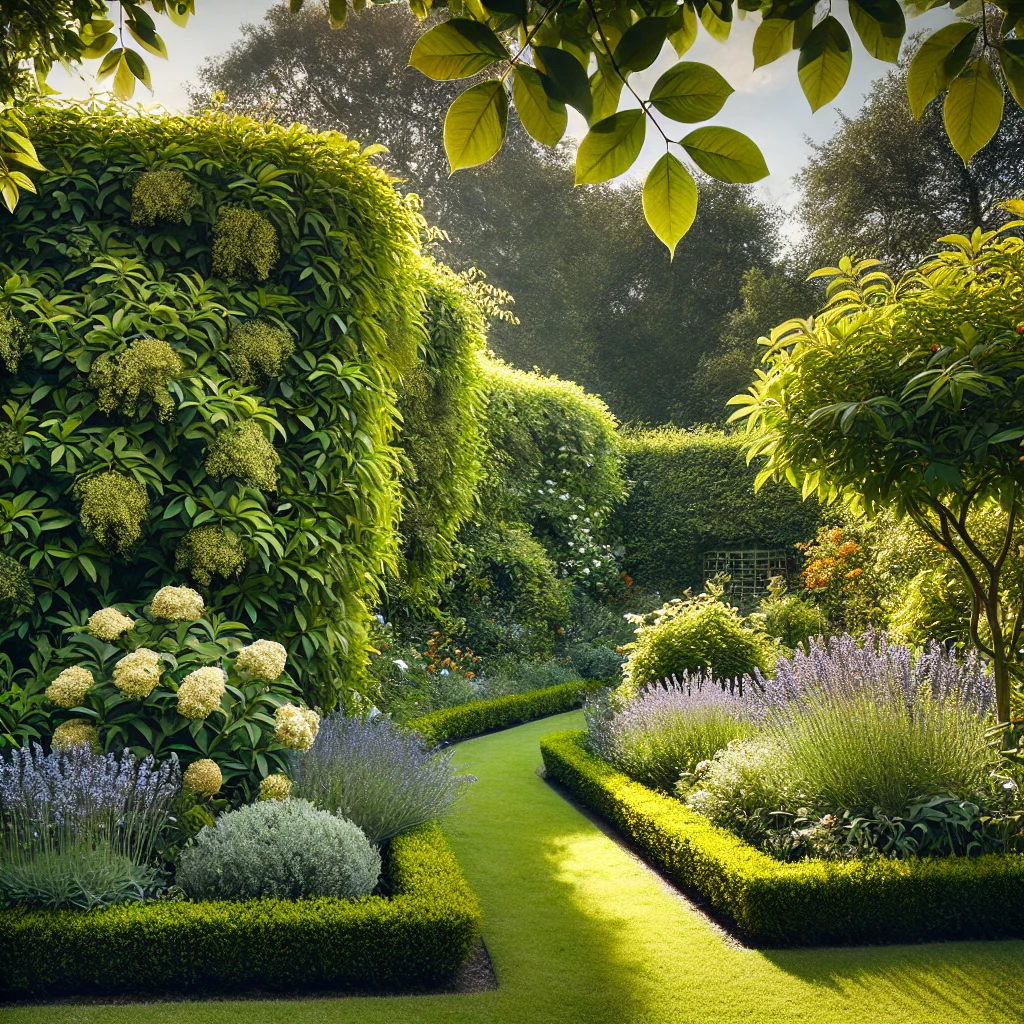
Griselinia seemed like the perfect choice. What I didn’t realize at the time was just how much this plant would transform my outdoor space, offering not just privacy but also an undeniable beauty.
One of the standout features of Griselinia is its adaptability. It thrives in a range of climates and soil types, making it suitable for coastal gardens, urban landscapes, and even more challenging conditions.
I live in an area with salty sea air, which can be tough on plants, but my Griselinia hedge grew effortlessly. Its tolerance for wind and occasional drought means I don’t have to worry about it losing its lushness during challenging weather. Instead, it stands tall, forming a natural, green wall that softens the edges of my property.
While its practicality is impressive, Griselinia’s true potential lies in its ability to bring beauty to your garden. Its glossy leaves create a striking visual effect, catching the light in a way that adds depth and vibrancy to any space.
I’ve planted mine along a garden path, and walking through it feels like stepping into a private sanctuary. The hedge frames the space beautifully, creating a sense of order without feeling rigid or overly formal.
Another thing I’ve come to appreciate is how Griselinia interacts with the rest of the garden. It provides a stunning backdrop for flowering plants, allowing their colors to pop against its rich green leaves.
I’ve paired my hedge with bright hydrangeas and lavender, and the combination is nothing short of breathtaking. The contrast between the structured greenery and the softer, more colorful flowers adds layers to the garden’s design, making it feel both intentional and inviting.
Griselinia also plays a role in supporting local wildlife. Its dense foliage provides shelter for birds, and I often spot sparrows and finches flitting in and out of the hedge. During the summer, the hedge becomes a buzzing hub of activity, as insects like bees find refuge among its branches.
Knowing that my garden contributes to the local ecosystem gives me a deep sense of satisfaction, turning what started as a practical project into something far more meaningful.
Maintaining a Griselinia hedge is surprisingly simple. With regular trimming, it stays dense and even, maintaining its elegant appearance. I usually prune mine twice a year—once in early spring and again in late summer.
The process is straightforward and gives me a chance to shape the hedge, whether I’m going for a clean, uniform look or something a little softer and more natural. Feeding the hedge with a balanced fertilizer in spring ensures that it stays vibrant and healthy, ready to push out fresh new growth.
One of my favorite things about Griselinia is how it can be used to create different effects in the garden. In addition to hedges, it works beautifully as a standalone feature plant or as part of a mixed border.
A friend of mine planted a single Griselinia in the center of her garden, shaping it into a small tree. The result is stunning—a living sculpture that draws the eye and anchors the space. Seeing her creative use of Griselinia inspired me to think beyond hedges, exploring other ways to incorporate this versatile plant into my garden.
Over the years, my Griselinia hedge has become more than just a solution for privacy. It’s a defining feature of my garden, providing structure, color, and a sense of calm. I’ve received countless compliments from visitors, many of whom are surprised by how much personality a simple hedge can bring to a space.
For me, it’s a reminder that sometimes the most unassuming plants have the greatest potential.
If you’re considering planting Griselinia, I can’t recommend it enough. Whether you’re looking to create a private retreat, add a touch of elegance to your garden, or simply enjoy the beauty of its vibrant foliage, this plant has so much to offer.
With a little care and creativity, you can unlock its full potential, transforming your outdoor space into something truly special. And as you watch it thrive, you’ll find that Griselinia is more than just a hedge—it’s a living, breathing part of your garden’s story.
The Secret to Growing a Dense and Beautiful Griselinia Hedge
A dense and beautiful Griselinia hedge can transform your outdoor space into a lush green sanctuary. Whether you’re looking for privacy, a windbreak, or a decorative boundary, Griselinia, with its glossy green leaves and fast growth, is a versatile and elegant choice.
But how do you get your hedge to grow thick and healthy? The secret lies in understanding its needs and providing consistent care.
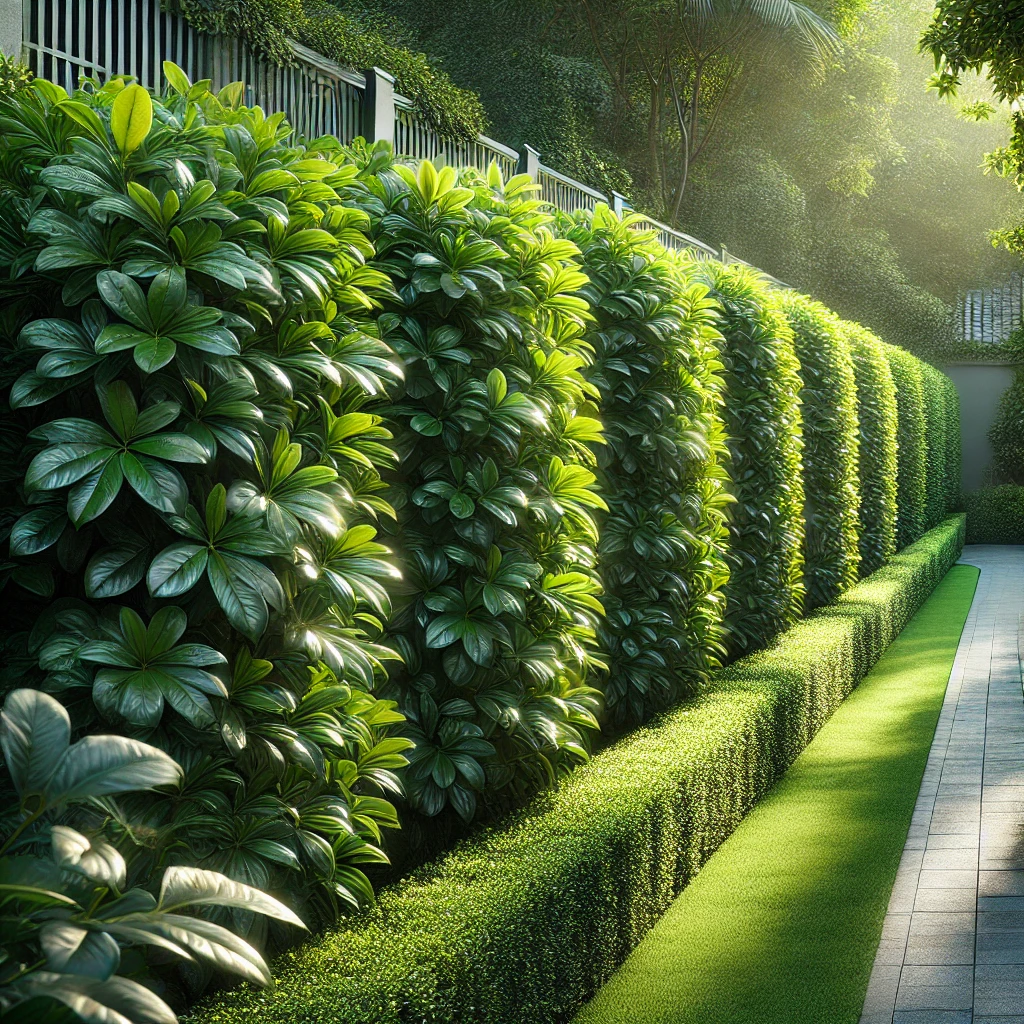
I remember the day I planted my first Griselinia hedge. My garden felt open and exposed, and I wanted a natural way to create privacy without losing the sense of greenery and life. Griselinia seemed like the perfect solution—evergreen, fast-growing, and easy to maintain. However, as excited as I was, I quickly realized that getting it to grow dense and full required a little patience and some trial and error.
The first thing I learned was that the location of your hedge makes a huge difference. Griselinia thrives in well-drained soil and prefers a spot with plenty of sunlight. Although it can tolerate partial shade, full sun encourages faster and more vigorous growth.
When I planted my hedge, I made sure to choose a sunny stretch along my garden’s boundary, and the results were noticeable within months. If your soil is heavy or clay-like, mixing in compost or organic matter before planting can improve drainage and give your hedge a strong start.
Watering is another key factor in growing a dense Griselinia hedge. During the first year, regular watering is essential to help the plants establish their roots. I made it a habit to water deeply once or twice a week, especially during dry spells.
Once the hedge was established, it became much more drought-tolerant, needing only occasional watering. However, I’ve found that during particularly hot summers, a little extra water goes a long way in keeping the foliage vibrant and glossy.
One mistake I made early on was underestimating the importance of spacing. I planted my Griselinia saplings too close together, thinking this would result in a thicker hedge more quickly. What happened instead was that the plants competed for resources, and some sections struggled to grow evenly.
After consulting a gardening friend, I replanted with proper spacing—about 50 to 60 centimeters apart—and the difference was remarkable. The plants had room to spread their roots and grow, resulting in a much healthier hedge.
Pruning is the real secret to achieving a dense Griselinia hedge. Regular trimming encourages the plants to grow bushier, filling out any gaps and creating that full, lush look we all admire. I prune my hedge twice a year—once in late spring and again in early autumn. This timing allows me to shape the hedge while promoting new growth.
The first time I pruned my hedge, I was nervous about cutting back too much, but I soon realized that Griselinia responds well to pruning. In fact, the more I trimmed, the thicker it grew.
Fertilizing is another crucial step that’s often overlooked. Griselinia benefits from a balanced fertilizer applied in early spring. I use a slow-release formula that provides nutrients over several months, giving the hedge the energy it needs for strong growth.
Adding a layer of organic mulch around the base of the plants also helps retain moisture and suppress weeds, while slowly breaking down to enrich the soil.
One year, I noticed that a few sections of my hedge were looking sparse despite my efforts. After some investigation, I realized that these areas were shaded by taller plants nearby, limiting the amount of sunlight the Griselinia was getting.
By trimming back the overhanging branches and ensuring the hedge had access to sunlight, the sparse areas began to fill out again. It was a reminder that even small changes in the environment can have a big impact on growth.
Pests and diseases can also affect the density and health of your hedge, though Griselinia is generally hardy and resilient. I’ve had the occasional issue with aphids, but a quick spray of soapy water or an organic insecticide always does the trick.
Leaf spots can sometimes appear in damp conditions, but improving airflow by trimming the hedge and keeping it well-spaced usually prevents this from becoming a problem.
What I’ve come to love most about my Griselinia hedge is how versatile it is. Whether I’m shaping it into a formal, structured boundary or letting it grow a little wilder for a natural look, it always delivers.
And beyond its practical uses, it brings so much beauty to my garden. The glossy green leaves catch the sunlight, creating a vibrant backdrop for flowers and other plants. Watching birds dart in and out of the hedge, finding shelter and nesting spots, has been an added joy.
Growing a dense and beautiful Griselinia hedge takes time and care, but the rewards are well worth it. By choosing the right location, watering consistently, pruning regularly, and providing the nutrients it needs, you’ll create a hedge that’s not only functional but also a stunning feature in your garden.
For me, my hedge has become more than just a boundary—it’s a living testament to the power of patience and nurture, transforming my outdoor space into a private, peaceful retreat.
Why Griselinia is the Perfect Evergreen for Any Garden
If you’re looking for an evergreen plant that can bring year-round beauty and practicality to your garden, Griselinia might just be the perfect choice. With its vibrant green foliage, hardy nature, and versatility, Griselinia has earned a reputation as one of the most reliable and appealing evergreens for gardeners.
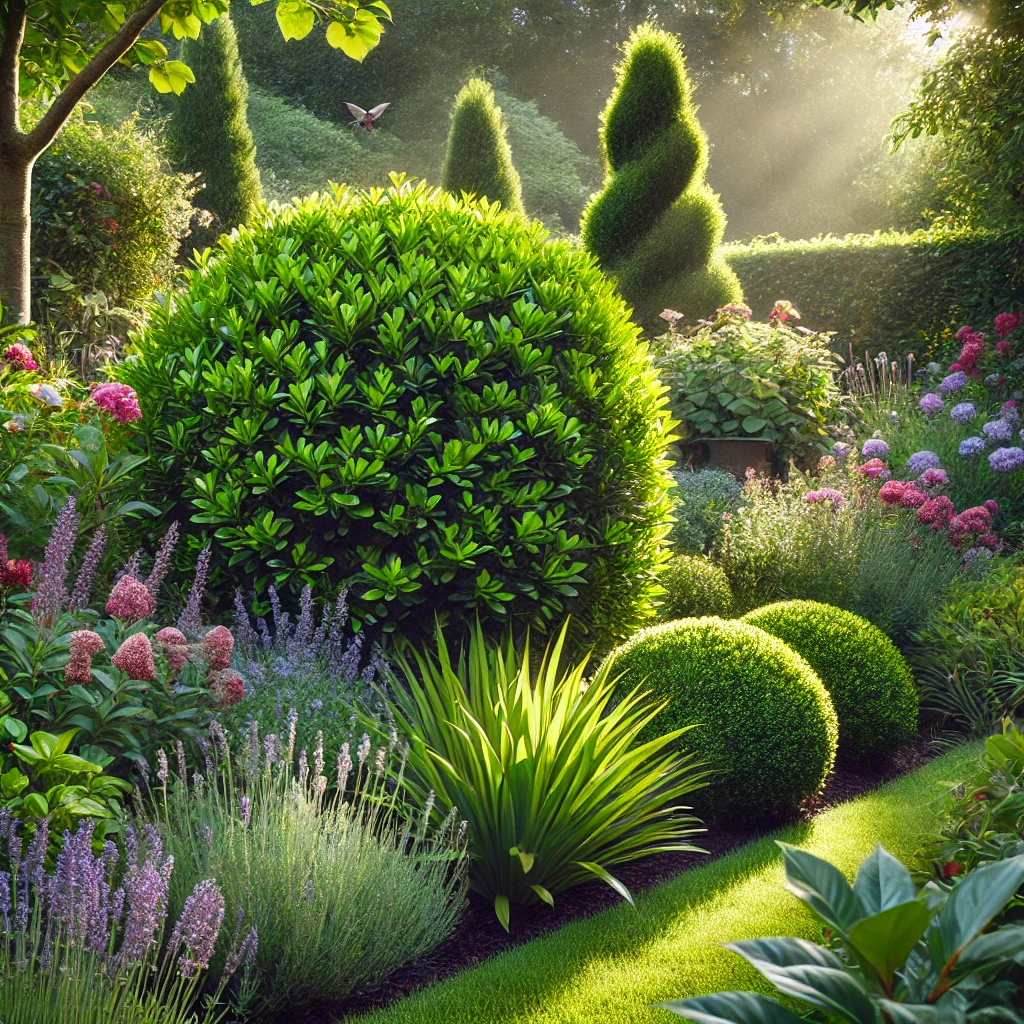
Whether you’re creating a privacy hedge, adding structure to your landscape, or simply looking for a low-maintenance option, Griselinia delivers on every front.
When I first planted Griselinia in my garden, I was struck by how quickly it established itself. I needed a natural screen to create privacy from neighboring properties, but I also wanted something that didn’t require constant attention.
Griselinia ticked all the boxes. Within a year, the plants had grown dense and lush, providing a beautiful green barrier that felt both functional and elegant.
One of the reasons Griselinia stands out is its adaptability. It thrives in a range of climates and soil types, making it suitable for coastal gardens, urban spaces, and everything in between.
My own garden is near the coast, where salty air and strong winds can make it tough for some plants to thrive. Griselinia, however, took these challenges in stride, maintaining its vibrant green color and sturdy growth throughout the year.
The glossy, apple-green leaves of Griselinia are another reason it’s so beloved. They create a fresh and polished look that brightens up even the gloomiest of spaces. I’ve paired my Griselinia hedge with flowering plants like lavender and hydrangeas, and the contrast between the vibrant green and the colorful blooms is stunning.
It’s a combination that adds depth and interest to my garden without requiring a lot of effort.
Griselinia’s low-maintenance nature is a blessing for busy gardeners or those just starting out. It requires minimal care to thrive. I water my hedge regularly during the first year to help the roots establish, but after that, it’s surprisingly drought-tolerant. A light trim twice a year keeps it looking neat and encourages bushier growth.
Feeding it with a balanced fertilizer in spring gives it a boost for the growing season, but even without constant feeding, it stays healthy and robust.
One of the best things about Griselinia is its versatility. It can be used as a formal hedge, a natural boundary, or even a standalone feature plant. In a friend’s garden, I saw a single Griselinia shaped into a small tree, surrounded by a bed of flowers.
The effect was striking and showed just how adaptable this plant can be. Whether you want clean lines or a softer, more natural look, Griselinia can do it all.
Griselinia also plays a role in supporting local wildlife. Its dense foliage provides shelter for birds, and the occasional small flowers attract pollinators like bees. In my own garden, I often see sparrows darting in and out of the hedge, using it as a safe spot to rest and nest. Knowing that my plants contribute to the ecosystem adds an extra layer of satisfaction to having them in my garden.
Another reason Griselinia is ideal for any garden is its resilience. It’s relatively pest-free and disease-resistant, which means you don’t have to worry about constant maintenance or treatments. Even when faced with less-than-ideal conditions, such as poor soil or partial shade, it still manages to thrive. For me, this resilience has made it a reliable backbone for my garden, providing structure and greenery that stays consistent no matter the season.
Over the years, my Griselinia hedge has become one of my favorite features in the garden. It’s not just a practical addition; it’s a plant that brings life and vibrancy to the space. The glossy green leaves catch the light beautifully, and their evergreen nature ensures that the garden looks lively even in the depths of winter.
If you’re considering adding Griselinia to your garden, you won’t be disappointed. It’s a plant that combines beauty, functionality, and ease of care, making it the perfect evergreen for gardeners of all levels.
Whether you’re looking to create a private retreat, define garden boundaries, or simply enjoy the elegance of its foliage, Griselinia is a choice that will reward you for years to come. With its adaptability, resilience, and year-round appeal, it truly is the perfect evergreen for any garden.
Griselinia Care Made Simple: Tips for Thriving Greenery Year-Round
Griselinia is a gardener’s dream plant. With its glossy green leaves, adaptability, and ability to thrive in various conditions, it’s a top choice for creating stunning hedges or adding structure to any landscape.

While Griselinia is known for being low-maintenance, a little care goes a long way in keeping it vibrant and healthy year-round. Whether you’re new to gardening or a seasoned enthusiast, learning a few simple care techniques can make all the difference.
When I first planted Griselinia, I was drawn to its vibrant color and promise of easy care. I envisioned a lush, green hedge that would provide privacy and serve as a backdrop for my flower beds. While it did grow effortlessly at first, I noticed some uneven patches and slower growth in certain areas.
That’s when I realized that even the hardiest plants benefit from a little extra attention.
The first key to Griselinia care is getting the planting right. It thrives in well-drained soil and does best in sunny spots, though it can tolerate partial shade. I planted my hedge along the sunniest side of the garden, and it quickly established itself.
If you’re working with heavier soil, adding some compost or organic matter can improve drainage and give your plants a strong start. In areas prone to wind, Griselinia also acts as a natural windbreak, so positioning it strategically can protect other parts of your garden.
Watering is essential during the first year to help your Griselinia hedge establish its root system. I made it a habit to water deeply once or twice a week, especially during dry spells. After that initial period, the hedge became surprisingly drought-tolerant.
Even during a particularly hot summer, my Griselinia remained lush and vibrant with just occasional watering. The key is to keep the soil moist but not waterlogged, as overwatering can lead to root issues.
Feeding your Griselinia is another simple way to ensure it stays healthy. In early spring, I like to apply a slow-release fertilizer to give the plants a nutrient boost as they enter the growing season.
Watching the fresh green growth emerge is one of my favorite signs of spring, and it’s always a reminder that a little care pays off. Adding a layer of organic mulch around the base of the plants also helps retain moisture, suppress weeds, and improve soil health.
Pruning is where the magic really happens. Regular trimming encourages bushier growth and helps your hedge maintain its shape. I prune my Griselinia twice a year—once in late spring and again in early autumn.
At first, I was hesitant to cut back too much, worried I might damage the plant. But I soon learned that Griselinia responds beautifully to pruning, bouncing back with even more vibrant growth. Light, consistent trimming is the secret to a dense, even hedge.
One challenge I’ve faced with Griselinia is dealing with occasional pests and diseases. While it’s generally resistant, leaf spots can appear during particularly wet seasons. To prevent this, I make sure my hedge has good airflow by thinning out overly dense sections during pruning.
If spots do appear, removing the affected leaves and ensuring the plants have plenty of sunlight usually solves the problem. Thankfully, serious issues are rare, and with regular care, my hedge stays healthy year after year.
Another thing I’ve come to appreciate is how Griselinia can adapt to different roles in the garden. While my primary focus has been on growing a hedge, I’ve also used it as a feature plant in other parts of the yard.
A single Griselinia, shaped into a small tree, makes a striking focal point in a flower bed or at the end of a pathway. Its versatility means you can get creative with how you incorporate it into your landscape.
One summer, I noticed birds beginning to nest in my Griselinia hedge. Watching sparrows dart in and out of the dense foliage was a delightful surprise, and it reminded me of the role plants play in supporting local ecosystems.
Beyond its aesthetic and practical benefits, Griselinia contributes to the environment by providing shelter for birds and insects. Knowing that my hedge is more than just a decorative feature makes caring for it even more rewarding.
Today, my Griselinia hedge is one of the most cherished parts of my garden. It’s lush, vibrant, and provides a sense of privacy and structure that ties everything together. The best part is that it thrives with just a little attention, proving that even the simplest care routines can yield stunning results.
If you’re considering planting Griselinia or want to ensure your existing hedge looks its best, remember that a bit of consistency goes a long way. From proper planting and watering to pruning and feeding, these small steps can make all the difference. With the right care, your Griselinia will reward you with year-round greenery and beauty that transforms your garden into a true sanctuary.
The History and Beauty of Griselinia: A Gardener’s Favorite
Griselinia is a plant that has quietly earned its place as one of the most beloved options for gardeners worldwide. With its vibrant green foliage, hardy nature, and versatility, it’s no surprise that this evergreen is a staple in gardens, parks, and landscapes.
But beyond its practical appeal lies a rich history and timeless beauty that make it a true gem for anyone who appreciates the art of gardening.
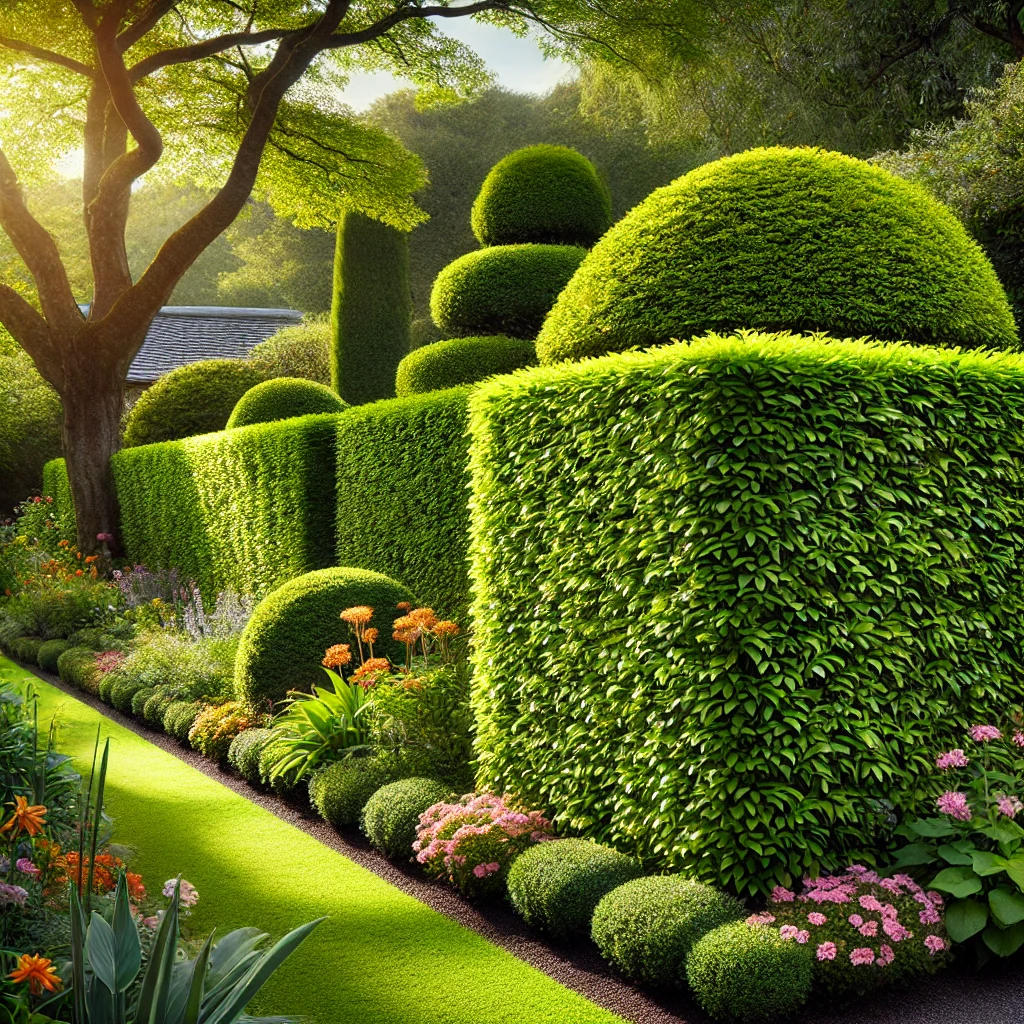
The story of Griselinia begins in the southern hemisphere, where it is native to New Zealand and parts of South America. In its natural habitat, it thrives in diverse conditions, from coastal regions to mountainous areas, showcasing its adaptability. This resilience caught the attention of horticulturists who saw its potential for cultivation in gardens far from its native soil.
By the 19th century, Griselinia was being introduced to gardens in Europe and beyond, quickly becoming a favorite for its evergreen qualities and low-maintenance nature.
I first discovered Griselinia while visiting a friend’s garden. She had planted it as a hedge along her property line, and its vibrant green leaves seemed to glow in the afternoon sunlight.
What struck me most was how effortlessly it blended with the rest of the garden, providing structure and privacy without feeling overwhelming. Inspired, I decided to plant my own Griselinia hedge, and it quickly became a defining feature of my outdoor space.
What makes Griselinia so appealing is its ability to adapt to a wide range of conditions. It thrives in well-drained soil but is also tolerant of clay and sandy soils. Its natural resistance to salty air makes it a favorite for coastal gardens, while its hardiness allows it to withstand cold winters and hot summers.
In my garden, which is often exposed to strong winds, Griselinia acts as a natural windbreak, protecting more delicate plants while maintaining its lush, glossy appearance.
The beauty of Griselinia lies in its simplicity. Its glossy green leaves create a polished, elegant look that can anchor a garden or act as a backdrop for more colorful plants. I’ve paired my Griselinia hedge with bright hydrangeas and lavender, and the contrast is nothing short of stunning. The hedge provides a sense of structure and calm, allowing the vibrant blooms to take center stage while still holding its own as a visual feature.
Over time, I’ve come to appreciate Griselinia not just for its beauty but also for its role in creating a haven for wildlife. The dense foliage provides shelter for birds, and I often spot sparrows and finches nesting among its branches.
Pollinators like bees are drawn to the small, inconspicuous flowers that appear in late spring, adding a subtle charm to the plant’s overall appeal. Knowing that my garden contributes to the local ecosystem makes caring for it even more rewarding.
Maintaining Griselinia is refreshingly simple, which adds to its popularity among gardeners of all skill levels. Regular pruning helps keep it neat and encourages bushier growth. I typically trim my hedge twice a year, once in spring and again in late summer and it responds beautifully, pushing out fresh, vibrant growth that enhances its already striking appearance.
A light application of fertilizer in the spring gives it an extra boost, ensuring it remains healthy and robust year-round.
What I love most about Griselinia is its versatility. While it’s commonly used as a hedge, it can also be shaped into standalone features or incorporated into mixed borders. I’ve seen Griselinia planted in large containers on patios, where its vibrant foliage adds a touch of greenery to urban spaces.
Its adaptability means you can get creative with how you use it in your garden, whether you’re looking for a formal, structured look or something more natural and relaxed.
The history of Griselinia adds an extra layer of appreciation for this plant. Its journey from the wilds of New Zealand and South America to gardens around the world is a testament to its resilience and universal appeal. It’s a plant that has stood the test of time, cherished by generations of gardeners for its practicality and beauty.
As I look at my own Griselinia hedge, I’m reminded of how much it has brought to my garden. It’s more than just a plant—it’s a living element that ties the space together, providing privacy, structure, and a sense of tranquility.
Whether you’re a seasoned gardener or just starting out, Griselinia is a choice that will reward you with its timeless elegance and unmatched versatility. Its history and beauty make it a true gardener’s favorite, and its presence will elevate any outdoor space for years to come.
Common Problems with Griselinia and How to Solve Them Naturally
Griselinia is a reliable and low-maintenance evergreen, loved by gardeners for its glossy green leaves and versatility. However, like any plant, it isn’t completely immune to problems. From pests to diseases and environmental stress, there are a few challenges that can arise when growing this otherwise hardy plant.

Fortunately, most of these issues can be managed with natural and straightforward solutions, ensuring your Griselinia hedge stays healthy and beautiful year-round.
One of the most common problems with Griselinia is leaf yellowing, often caused by overwatering or poor drainage. I remember the first time I noticed the leaves on my hedge turning yellow; I panicked, thinking I had somehow failed as a gardener. After a bit of research, I realized that the soil around the plants wasn’t draining well enough, leading to root stress.
To fix the problem, I improved the drainage by mixing compost into the soil and reducing the frequency of watering. Within weeks, the hedge began to recover, with new green growth replacing the yellowed leaves.
Another issue that can affect Griselinia is leaf spot, a fungal disease that creates brown or black spots on the leaves. This problem often occurs in wet or humid conditions, where moisture lingers on the foliage. I’ve had to deal with this in my garden after a particularly rainy season.
To manage it, I made sure to prune the hedge to improve airflow, allowing the leaves to dry quickly after rainfall. Spraying the affected areas with a natural fungicide made from diluted neem oil worked wonders, and the hedge bounced back beautifully.
Pests like scale insects and aphids are occasional nuisances for Griselinia, but they’re usually easy to manage. One summer, I noticed sticky residue on some of the leaves, which was a sign of aphid activity. Instead of reaching for chemical sprays, I opted for a natural solution.
A simple mixture of water, a few drops of dish soap, and a splash of neem oil sprayed onto the affected areas took care of the problem. Ladybugs, which are natural predators of aphids, also helped keep the pest population under control.
Environmental stress, such as windburn or frost damage, can also impact Griselinia, particularly in exposed areas. The leaves may turn brown or curl at the edges, making the plant look less vibrant.
I’ve found that mulching around the base of the hedge helps regulate soil temperature and moisture, reducing stress during extreme weather. Planting the hedge in a more sheltered location or providing temporary windbreaks during stormy seasons can also make a big difference in preventing damage.
Poor growth or patchy sections in a Griselinia hedge are often caused by insufficient sunlight or overcrowding. In my garden, one side of the hedge struggled because it was shaded by a nearby tree.
Once I trimmed back some of the overhanging branches to allow more sunlight in, the hedge began to fill out again. Spacing the plants correctly during planting is also crucial; giving each plant enough room to grow prevents competition for nutrients and ensures a dense, even hedge.
Salt buildup in the soil is another potential issue for Griselinia, especially in coastal gardens. While the plant is known for its salt tolerance, excessive buildup can still cause stress. If you notice stunted growth or leaf discoloration, flushing the soil with water to remove excess salt can help.
I do this in my own coastal garden every few months, and it keeps my Griselinia thriving despite the salty air.
Maintaining a regular care routine is one of the best ways to prevent problems before they arise. Healthy, well-fed plants are naturally more resistant to pests and diseases. I like to feed my Griselinia hedge with a balanced organic fertilizer in spring, which supports new growth and strengthens the plants.
Pruning regularly to remove dead or diseased branches also helps the hedge stay healthy and vibrant.
Through trial and error, I’ve learned that natural solutions often work just as well—if not better—than chemical treatments. Not only do they protect the health of the plant, but they also support the broader garden ecosystem.
By encouraging beneficial insects and using eco-friendly sprays, I’ve managed to keep my Griselinia hedge thriving without disrupting the delicate balance of nature in my garden.
Griselinia may have its challenges, but with a little care and attention, these problems are easy to overcome. By addressing issues early and taking preventative measures, you can enjoy the full beauty and functionality of this versatile plant.
For me, caring for my Griselinia hedge has become more than just a gardening task; it’s a rewarding experience that deepens my connection to the natural world. When I see its lush, green leaves standing strong, I’m reminded that even the most resilient plants flourish with a bit of love and care.
Griselinia Hedge Maintenance: A Practical Guide for Homeowners
A lush, well-maintained Griselinia hedge can completely transform your garden, offering privacy, structure, and a splash of vibrant green. While Griselinia is a hardy and low-maintenance plant, a little care goes a long way in keeping it looking its best.

Whether you’re new to gardening or a seasoned homeowner, understanding the basics of Griselinia hedge maintenance will ensure it thrives for years to come. With a few practical steps, you can enjoy a hedge that’s both beautiful and functional.
When I first planted my Griselinia hedge, I was drawn to its glossy green leaves and fast-growing nature. It seemed like the perfect choice for creating a natural boundary in my backyard. But as the seasons passed, I realized that maintaining a hedge isn’t just about letting it grow; it requires regular attention. The first year was a learning curve, but with some trial and error, I discovered that consistency and a little effort made all the difference.
One of the first things I learned was the importance of proper watering, especially during the early stages. Griselinia needs regular watering while it establishes its root system. I made the mistake of watering too lightly at first, not realizing that deep, infrequent watering is far more effective. By soaking the soil thoroughly once a week, I saw my hedge develop a strong root network that kept it healthy even during dry spells.
Pruning is another essential part of Griselinia maintenance. Regular trimming not only keeps the hedge looking neat but also encourages bushier growth, which is key to creating a dense, even barrier.
I typically prune mine twice a year—once in late spring and again in early autumn. When I first started pruning, I was nervous about cutting back too much, but I quickly learned that Griselinia responds well to trimming. Each time, the hedge bounced back with fresh, vibrant growth, filling out any sparse areas.
Feeding your hedge is equally important. A balanced fertilizer applied in early spring provides the nutrients needed for vigorous growth. I use a slow-release formula to ensure the plants get a steady supply of nutrients throughout the growing season. Adding a layer of organic mulch around the base of the hedge also helps retain moisture and enrich the soil, giving the plants the best chance to thrive.
Occasionally, I’ve dealt with minor challenges like yellowing leaves or slower growth in shaded areas. Yellowing is often a sign of overwatering or poor drainage, so I made sure the soil around my hedge was well-drained and adjusted my watering routine.
For the shaded areas, I trimmed back overhanging branches from nearby trees to allow more sunlight to reach the hedge. Small adjustments like these made a noticeable difference, and the hedge quickly regained its vibrancy.
Keeping an eye out for pests and diseases is another part of maintaining a healthy Griselinia hedge. While it’s a relatively pest-resistant plant, issues like aphids or fungal leaf spots can occasionally arise.
I’ve found that a natural neem oil spray works well for controlling pests, and improving airflow through regular pruning helps prevent fungal problems. Staying vigilant and addressing issues early ensures they don’t spread or cause lasting damage.
One of the things I love most about my Griselinia hedge is how it evolves with the seasons. In spring, new growth emerges in a bright, almost lime-green hue that gradually deepens as the summer progresses.
Watching the hedge change throughout the year is a reminder of the rewards of consistent care. It’s also a great way to connect with your garden and appreciate the effort you’ve put into creating a thriving outdoor space.
Over the years, my Griselinia hedge has become one of the most cherished features of my garden. It’s more than just a privacy screen; it’s a living, breathing element that adds beauty and structure to the landscape. Regular maintenance has not only kept it healthy but has also made it a source of pride and enjoyment.
If you’re looking to keep your Griselinia hedge in top shape, remember that small, consistent efforts are the key. From watering and pruning to feeding and pest control, each step contributes to the overall health and appearance of your hedge.
With a little care and attention, you’ll have a Griselinia hedge that enhances your home and garden for years to come.
The Evolution of Griselinia in Modern Landscaping
Griselinia nz has quietly become a cornerstone of modern landscaping, thanks to its adaptability, beauty, and resilience. While this vibrant evergreen has its roots in the wild landscapes of New Zealand and parts of South America, it has evolved into a must-have plant for gardeners and landscapers worldwide.

Its journey from a native shrub to a polished feature in manicured gardens is a testament to its versatility and timeless appeal.
The first time I encountered Griselinia was in a friend’s garden, where it formed a neat, vibrant hedge that framed her outdoor space beautifully. She mentioned how easy it was to grow, and its ability to provide year-round greenery piqued my interest.
At the time, I was struggling with a few finicky plants that required constant care, and the idea of a hardy, low-maintenance hedge sounded like a dream. Little did I know, this unassuming plant had a rich history and a growing reputation in the world of landscaping.
Griselinia’s popularity can be traced back to its practical qualities. It thrives in various climates, from coastal areas with salty winds to urban gardens with limited space and challenging soil. In my garden, it withstood harsh winters and dry summers alike, remaining lush and vibrant through it all.
Its adaptability made it a favorite for professionals designing spaces that needed plants capable of handling diverse conditions without sacrificing beauty.
As modern landscaping evolved to emphasize simplicity and functionality, Griselinia found its place in a variety of roles. For many homeowners, it became the ideal choice for creating privacy screens that were both effective and attractive.
My own hedge has grown into a dense, living wall that provides seclusion without feeling rigid or imposing, softening the lines of my garden in a way that fences or walls never could.
Designers also began to explore Griselinia’s potential beyond traditional hedges. It has been used as a feature plant in mixed borders, where its glossy green leaves provide a striking contrast to colorful perennials.
I’ve experimented with using Griselinia as a centerpiece in a flower bed, shaping it into a small tree that adds height and structure. This flexibility makes it an invaluable tool for creating dynamic, layered designs that look good year-round.
One of the more recent trends in modern landscaping is the use of Griselinia in urban green spaces. In cities where gardens are often limited to balconies or courtyards, Griselinia has proven itself as an excellent container plant.
A neighbor of mine has a row of potted Griselinia on her patio, and it creates a lush, green backdrop that makes the small space feel like a private retreat. The plant’s ability to thrive in confined spaces while still offering that unmistakable vibrancy has expanded its appeal to urban dwellers.
The environmental benefits of Griselinia have further cemented its place in contemporary garden design. Its dense foliage acts as a natural air filter, capturing dust and pollutants while releasing oxygen. I’ve noticed that the air around my hedge feels fresher, especially during hot, dusty summers.
Its ability to support local wildlife is another bonus. Birds often nest in its branches, and pollinators like bees are drawn to its small, understated flowers.
Griselinia’s rise in modern landscaping isn’t just about function—it’s also about aesthetics. Its clean lines and vibrant color complement the minimalist designs that have become popular in recent years.
I’ve seen Griselinia used in contemporary gardens where it’s shaped into geometric forms, creating a striking contrast against sleek stone patios and metal sculptures. Its timeless look allows it to bridge the gap between traditional and modern styles effortlessly.
What I appreciate most about Griselinia is how it has adapted to the changing demands of gardeners and landscapers while still staying true to its roots. It remains a plant that’s easy to care for, making it accessible to beginners, but its versatility means it can be used in innovative ways by experienced designers.
In my own garden, it’s a reminder of how simplicity can be powerful. Its understated beauty and reliability make it a standout feature, whether it’s serving as a hedge, a focal point, or a backdrop.
As we look to the future, it’s clear that Griselinia will continue to play a significant role in modern landscaping. Its ability to adapt to different environments, support sustainable gardening practices, and bring year-round beauty to any space ensures its place as a gardener’s favorite.
For me, growing Griselinia has been more than just a practical choice—it’s been a journey of discovering the endless possibilities that come with this remarkable plant. Whether you’re a seasoned landscaper or a novice gardener, Griselinia offers something truly special.
Why Griselinia Is the Best Choice for Windy Locations
Windy gardens can be a challenge for even the most experienced gardeners. The constant battering of gusts can damage delicate plants, dry out soil, and create an environment that feels exposed and inhospitable.

If you’re struggling to find a plant that thrives in windy conditions while still bringing beauty and functionality to your space, look no further than the Griselinia nz has on offer. This hardy evergreen is perfectly suited for breezy locations, offering both resilience and aesthetic appeal.
I live in a coastal area where the wind often feels like an uninvited guest in my garden. For years, I tried planting various hedges to create a windbreak, but none seemed to withstand the constant gusts.
Then, a neighbor recommended Griselinia. She had a hedge that not only looked lush and vibrant but also stood strong against the relentless sea breeze. Inspired, I decided to give it a try, and I’ve never looked back.
What makes Griselinia so well-suited to windy locations is its tough yet flexible structure. Unlike more brittle plants, its branches are strong enough to hold their shape yet flexible enough to bend with the wind instead of breaking.
This unique combination allows it to act as a buffer, reducing the wind’s intensity and protecting more delicate plants in your garden. Within a few months of planting my Griselinia hedge, I noticed that the sheltered side of my garden started flourishing, with flowers and shrubs thriving in the calmer conditions.
Another reason Griselinia is ideal for windy locations is its salt tolerance. In coastal gardens, where salty air often wreaks havoc on vegetation, Griselinia stands out for its ability to remain unaffected.
My hedge is planted along the boundary closest to the sea, and despite the salty breeze, its glossy green leaves have stayed healthy and vibrant. This resilience has made it a favorite for coastal gardeners looking for a reliable and attractive windbreak.
Establishing a Griselinia hedge is straightforward, even in challenging conditions. When I planted mine, I made sure to choose a sunny spot with well-drained soil, as these are the ideal conditions for the plant to thrive.
I spaced the saplings about 50 centimeters apart, allowing them enough room to grow into a dense and uniform barrier. Regular watering during the first year helped the hedge establish its roots, and after that, it became surprisingly low-maintenance.
Pruning has been another key to keeping my hedge in top shape. Regular trimming encourages bushier growth, which enhances its ability to block wind and create privacy. I prune mine twice a year, in spring and late summer, using sharp shears to make clean cuts. Each time, the hedge responds with fresh, vibrant growth that adds to its overall density and strength.
In addition to its practical benefits, Griselinia brings undeniable beauty to windy gardens. Its glossy green leaves catch the sunlight, creating a polished look that softens the edges of any space.
I’ve paired my hedge with colorful flowering plants like lavender and agapanthus, and the contrast between the vibrant green and the bright blooms is stunning. Even on the windiest days, my garden feels like a calm and inviting retreat.
Beyond its aesthetic and functional appeal, Griselinia also plays a role in supporting the local ecosystem. Its dense foliage provides shelter for birds, and I often see sparrows nesting among its branches.
Knowing that my hedge offers a haven for wildlife adds an extra layer of satisfaction to having it in my garden. It’s a reminder that the right plant can benefit not just your space but the environment around it as well.
If you’re considering planting a Griselinia hedge in a windy location, my best advice is to start with healthy, well-spaced saplings and invest time in regular care during the first year. Deep watering, occasional feeding, and consistent pruning will set the stage for a hedge that thrives for decades to come.
The effort is minimal compared to the rewards—a beautiful, resilient barrier that transforms your garden into a more protected and welcoming space.
Today, my Griselinia hedge stands as a testament to the power of choosing the right plant for the right conditions. It has turned what was once an exposed, challenging garden into a tranquil and vibrant haven.
If your outdoor space is battling the wind, Griselinia might just be the solution you’ve been looking for. With its resilience, beauty, and ability to adapt, it truly is the best choice for windy locations.
Griselinia vs. Other Evergreens: What Sets It Apart
When it comes to choosing the perfect evergreen for your garden, the options can feel endless. From classic favorites like boxwood and holly to robust laurels, each evergreen has its own charm and appeal.
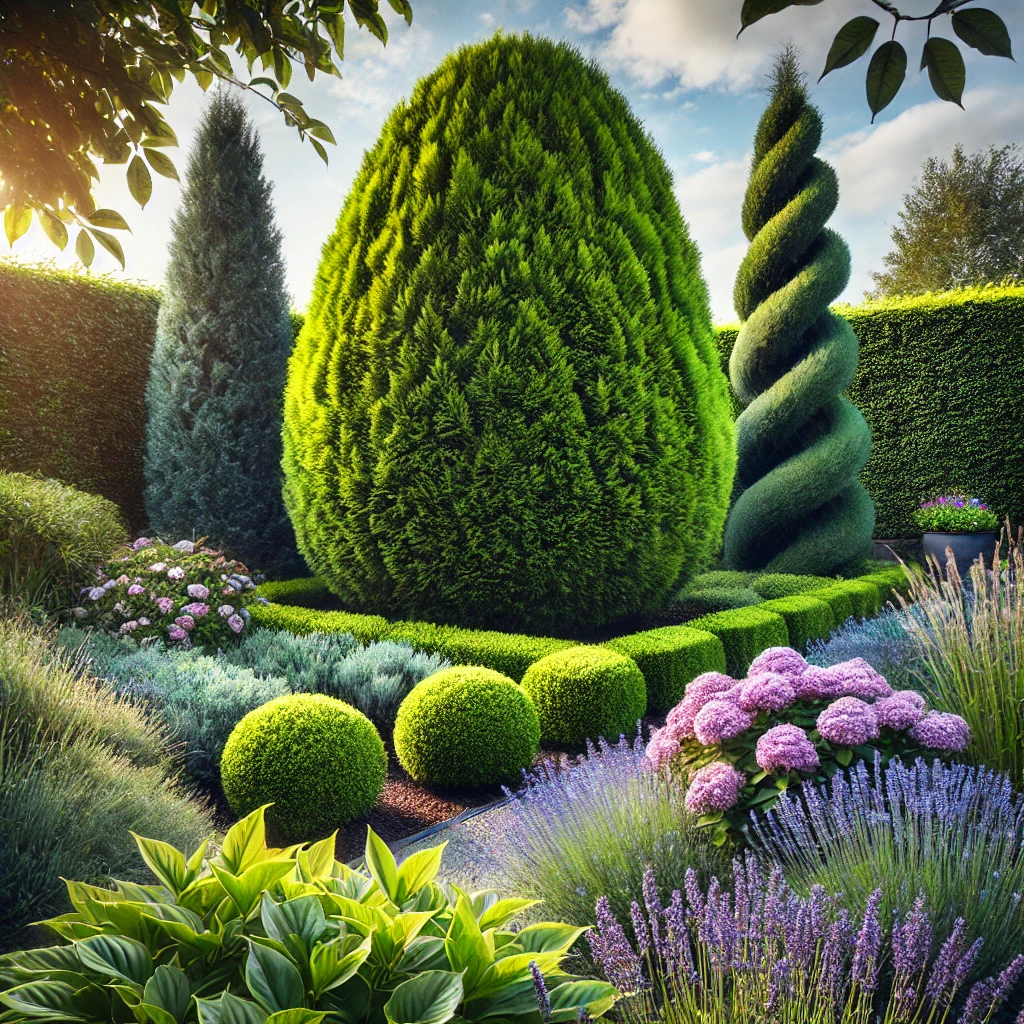
But one plant that consistently stands out is Griselinia. With its unique combination of beauty, resilience, and versatility, Griselinia offers qualities that other evergreens simply can’t match.
I first encountered Griselinia while visiting a friend’s coastal garden. The hedge framed the property beautifully, its glossy green leaves vibrant even in the salty sea air. I was impressed by how effortlessly it seemed to thrive, especially when my own hedge at home made of another evergreen was struggling against the same coastal conditions.
That was the moment I realized Griselinia wasn’t just another evergreen; it was a standout performer.
One of the main qualities that sets Griselinia apart is its adaptability. While many evergreens prefer specific conditions, Griselinia thrives in a wide range of environments. It handles coastal winds, salty air, and even partial shade with ease.
In contrast, other evergreens like boxwood can be finicky about soil drainage and sunlight, often requiring more attention to keep them healthy. For me, this hardiness was a game-changer, as it allowed me to plant Griselinia in spots where other plants had previously failed.
Another feature that makes Griselinia special is its rapid growth. While many traditional evergreens take years to fill out, Griselinia grows quickly, forming a dense, lush hedge in a fraction of the time. I planted mine along a boundary line in the hopes of creating privacy, and within two years, it had grown into a beautiful, impenetrable screen. Compared to the slower-growing hollies I had tried before, the results were nothing short of remarkable.
Griselinia’s aesthetic appeal is another reason it stands out. Its leaves are larger and glossier than those of many other evergreens, giving it a vibrant and polished look that instantly elevates a garden. I’ve paired my Griselinia hedge with colorful perennials like hydrangeas and lavender, and the contrast is stunning. Unlike darker, more muted evergreens, Griselinia adds brightness to the landscape, making it feel fresh and inviting.
Low maintenance is another key advantage of Griselinia. While other evergreens often require regular feeding, precise pruning, and careful watering, Griselinia is relatively self-sufficient once established. My hedge only needs a light trim twice a year to maintain its shape, and its drought tolerance has been a lifesaver during dry summers. In comparison, the boxwoods I used to grow required constant attention to avoid browning or becoming too leggy.
Despite its low-maintenance nature, Griselinia isn’t immune to challenges. Like any plant, it can experience issues like leaf spot or yellowing if conditions aren’t ideal. However, I’ve found these problems easy to manage with proper care, such as ensuring good drainage and pruning for airflow. Compared to other evergreens that are prone to pests or diseases, Griselinia’s issues are minimal and straightforward to address.
Another reason Griselinia outshines other evergreens is its environmental benefits. Its dense foliage provides excellent shelter for birds, making it a favorite nesting spot in my garden. I often see sparrows darting in and out of the hedge, and knowing that it supports local wildlife adds to my appreciation for this plant.
While many evergreens offer similar benefits, Griselinia’s fast growth and dense structure make it particularly effective as a habitat.
Griselinia also excels in versatility. While it’s most commonly used as a hedge, it can be shaped into standalone feature plants or incorporated into mixed borders. I’ve seen Griselinia pruned into elegant small trees, creating striking focal points in both formal and informal gardens.
Its adaptability means it works equally well in traditional landscapes and modern designs, giving it an edge over more specialized evergreens.
When comparing Griselinia to other popular evergreens, it’s clear why it’s become such a favorite among gardeners. It combines the best qualities of an evergreen beauty, durability, and year-round appeal with unique traits like fast growth and low maintenance.
For me, switching to Griselinia was one of the best decisions I’ve made for my garden. It has transformed my outdoor space, creating privacy, structure, and a sense of calm that other evergreens struggled to deliver.
If you’re looking for an evergreen that goes beyond the basics, Griselinia is an excellent choice. Whether you need a hedge, a feature plant, or a backdrop for more colorful blooms, it has the versatility and resilience to thrive in almost any setting. In a world full of evergreens, Griselinia is a true standout—one that will bring beauty and functionality to your garden for years to come.
Why Griselinia Is the Green Backbone of Beautiful Gardens
Every garden needs a strong foundation, a plant that ties everything together while adding structure, beauty, and functionality. For many gardeners, Griselinia has become that backbone. Its vibrant green foliage, adaptability, and low-maintenance nature make it a standout choice for creating stunning outdoor spaces.
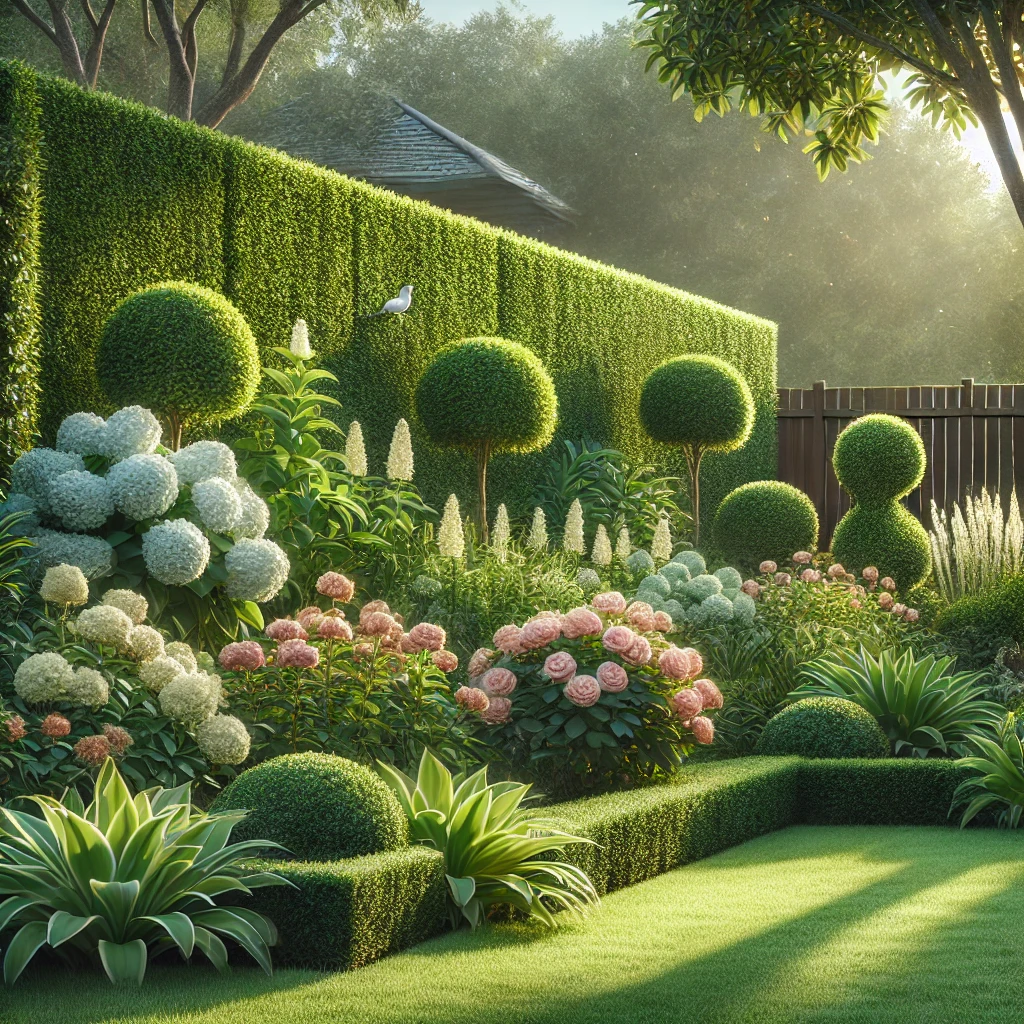
Whether you’re crafting a lush retreat or a minimalist landscape, Griselinia provides the perfect framework for your garden.
When I first planted Griselinia, I was looking for something to provide privacy along the edge of my property. I was drawn to its glossy green leaves, which instantly brightened up the space, and its promise of fast, dense growth.
Within a year, the hedge had grown into a lush barrier that not only gave me the seclusion I wanted but also added a polished, cohesive look to the garden. What I didn’t realize at the time was how much this plant would shape the overall design of my outdoor space.
One of the reasons Griselinia works so well as a garden backbone is its versatility. It can be used as a hedge, a feature plant, or even in a mixed border. I’ve seen it in gardens of all styles, from modern minimalist spaces where it’s trimmed into clean, geometric shapes to more naturalistic landscapes where it grows freely alongside flowering perennials.
In my own garden, I’ve used it to create a soft yet defined boundary between the lawn and the flower beds, and the effect is both practical and visually pleasing.
Griselinia’s adaptability extends beyond its design uses. It thrives in a wide range of conditions, from coastal gardens exposed to salty winds to urban spaces with limited sunlight. My garden is in a windy area, and many plants I tried before struggled to survive.
Griselinia, on the other hand, flourished, standing strong against the elements while maintaining its vibrant color and lush growth. Its resilience has made it an essential part of my garden’s foundation.
Another reason Griselinia is such an effective backbone plant is its year-round appeal. Unlike seasonal blooms that come and go, its evergreen foliage provides constant color and structure, anchoring the garden through every season.
In winter, when the rest of the garden feels bare, my Griselinia hedge remains a vibrant green, giving the space a sense of life and continuity. It’s a reminder that a garden’s beauty doesn’t have to fade with the seasons.
Griselinia also plays well with other plants, making it an excellent choice for creating harmony in the garden. I’ve paired mine with flowering shrubs like hydrangeas and roses, and the contrast between the bright green leaves and the colorful blooms is stunning.
It acts as a neutral canvas that allows other plants to shine while still holding its own as a feature. This ability to complement and enhance its surroundings is one of the reasons it has become such a popular choice among gardeners.
Low maintenance is another factor that makes Griselinia an ideal backbone plant. Once established, it requires minimal care to thrive. I water mine deeply during dry spells and give it a light trim twice a year to maintain its shape.
Compared to some of the more high-maintenance plants in my garden, Griselinia is refreshingly easy to care for, allowing me to focus my attention on other parts of the garden.
Its environmental benefits are yet another reason to love Griselinia. The dense foliage provides shelter for birds, and I often see sparrows and finches nesting in my hedge.
Pollinators like bees are drawn to its small flowers, adding to the garden’s biodiversity. Knowing that my choice of plant supports the local ecosystem adds an extra layer of satisfaction to having Griselinia as the foundation of my garden.
Over the years, I’ve come to appreciate how much Griselinia contributes to the overall feel of my garden. It creates a sense of order and structure, while its vibrant green color brings a feeling of freshness and energy. It’s the element that ties everything together, ensuring the garden looks cohesive and balanced no matter the season.
If you’re looking for a plant that can anchor your garden while providing beauty, functionality, and ease of care, Griselinia is the perfect choice. Its versatility, resilience, and year-round appeal make it more than just a hedge—it’s the green backbone that supports and enhances the entire garden.
For me, planting a Griselinia hedge has been one of the best decisions I’ve made, and I know it will continue to be a cornerstone of my outdoor space for years to come.
New Zealand Hedging Plants – Quickhedge Has Them All
When it comes to creating a beautifully landscaped garden, hedging plants are the unsung heroes that bring structure, privacy, and year-round appeal to your outdoor space. In New Zealand, where diverse climates and stunning landscapes inspire gardeners across the country, finding the right hedging plants is essential.

That’s where Quickhedge comes in. Offering a wide range of hedging options, Quickhedge provides everything you need to create lush, attractive, and practical hedges that thrive in New Zealand’s unique conditions.
One of the most popular choices for New Zealand hedging plants is Buxus. Known for its compact growth, glossy green foliage, and timeless appeal, Buxus is a versatile plant that works well in both formal and contemporary gardens.
When I first started gardening, I wasn’t sure if I could maintain New Zealand hedging plants as pristine as the ones I admired in parks and show gardens. Quickhedge made it easy by not only providing high-quality plants but also offering advice on planting and care.
Planting Buxus is straightforward, but a little preparation goes a long way. I learned that choosing the right location is key, as Buxus thrives in well-drained soil and areas with plenty of sunlight. Before planting,
I loosened the soil and mixed in organic compost to give the plants a nutrient-rich foundation. Quickhedge provided detailed instructions, which gave me the confidence to space the plants evenly and ensure they had enough room to grow into a dense, uniform hedge.
Maintaining Buxus through New Zealand’s changing seasons is all about understanding its needs. In spring, when new growth appears, it’s the perfect time to give your hedge a light trim. I use sharp shears to shape the hedge and encourage bushier growth. Adding a slow-release fertilizer in early spring has been a game-changer for me, as it keeps the foliage vibrant and healthy during the active growing season.
Summer presents its own challenges, especially in regions where heat and humidity can stress plants. Quickhedge recommends deep, infrequent watering to ensure the roots stay hydrated without oversaturating the soil. I’ve also added a layer of mulch around the base of my hedge, which helps retain moisture and keeps the roots cool during those hotter months. These simple steps have kept my hedge looking lush, even in the driest spells.
One of the things I appreciate most about Quickhedge when it comes to New Zealand hedging plants is their attention to detail when it comes to plant health. Buxus blight can be a concern, especially in humid conditions, but with the right care, it’s entirely manageable.
I’ve followed their advice to prune for better airflow, water directly at the base of the plants, and keep an eye out for early signs of blight, such as browning leaves. Quickhedge even provides resistant varieties for gardeners who want an extra layer of protection.
Autumn is a great time to prepare your hedge for winter. A final trim in late autumn ensures that the hedge stays neat and tidy during the colder months. Quickhedge also emphasizes the importance of feeding your plants before winter to give them the nutrients they need to weather the season. I’ve started applying an organic mulch before winter sets in, and it’s made a noticeable difference in keeping my hedge healthy and resilient.
Winter care is relatively low-key, but it’s important to protect young or newly planted hedges from frost. When it comes to New Zealand hedging plants, Quickhedge recommends using frost cloth for exposed areas and avoiding heavy pruning during this dormant period. In my garden, I’ve found that simply clearing away fallen leaves and debris around the base of the hedge keeps pests and diseases at bay while maintaining a clean, healthy appearance.
Beyond Buxus, Quickhedge offers an impressive selection of other hedging plants that cater to different needs and styles. For a more modern look, I’ve experimented with Ficus Tuffi, which grows quickly and creates a sleek, glossy green screen.
For a touch of color, I’ve added Red Robin hedges in a few areas, and their vibrant red foliage has become a highlight of my garden. Quickhedge’s range ensures that whether you’re creating a formal garden, a native retreat, or something entirely unique, you’ll find the perfect plants to bring your vision to life.
One of the reasons I keep returning to Quickhedge is the quality of their plants and the support they provide. Every plant I’ve received has been healthy and well-established, making it easy to get my hedges off to a strong start.
Their team is always available to answer questions, whether it’s about choosing the right plant for a specific location or troubleshooting a problem. For a novice gardener like me, this kind of guidance has been invaluable.
Creating a hedge isn’t just about planting a row of shrubs; it’s about adding a living, evolving feature to your garden that enhances its beauty and functionality year-round. With Quickhedge, maintaining lush, attractive New Zealand hedging plants changing seasons is not only achievable but also deeply rewarding.
Whether you’re a seasoned gardener or just starting out, their plants and expertise make it easy to create a space you’ll love for years to come.
As I look at my garden today, I’m amazed at how much it’s transformed since I planted my first Buxus hedge. What started as a simple project has become a passion, thanks in large part to the support and resources from Quickhedge.
Their dedication to quality and customer success ensures that every gardener, no matter their experience level, can enjoy the timeless beauty of New Zealand hedging plants in their outdoor spaces. If you’re ready to elevate your garden with hedges that thrive in every season, Quickhedge truly has it all.
